A Step-by-Step Plan for Teaching Argumentative Writing
February 7, 2016
Can't find what you are looking for? Contact Us
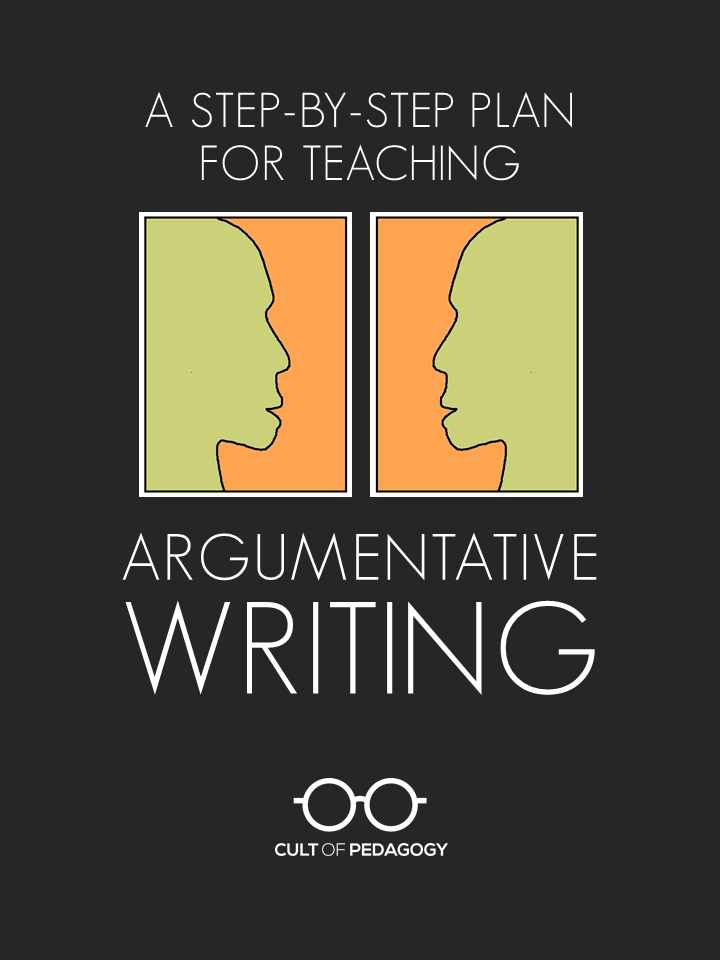
Listen to this post as a podcast:
This page contains Amazon Affiliate and Bookshop.org links. When you make a purchase through these links, Cult of Pedagogy gets a small percentage of the sale at no extra cost to you. What’s the difference between Amazon and Bookshop.org?
For seven years, I was a writing teacher. Yes, I was certified to teach the full spectrum of English language arts—literature, grammar and usage, speech, drama, and so on—but my absolute favorite, the thing I loved doing the most, was teaching students how to write.
Most of the material on this site is directed at all teachers. I look for and put together resources that would appeal to any teacher who teaches any subject. That practice will continue for as long as I keep this up. But over the next year or so, I plan to also share more of what I know about teaching students to write. Although I know many of the people who visit here are not strictly English language arts teachers, my hope is that these posts will provide tons of value to those who are, and to those who teach all subjects, including writing.
So let’s begin with argumentative writing, or persuasive writing, as many of us used to call it. This overview will be most helpful to those who are new to teaching writing, or teachers who have not gotten good results with the approach you have taken up to now. I don’t claim to have the definitive answer on how to do this, but the method I share here worked pretty well for me, and it might do the same for you. If you are an experienced English language arts teacher, you probably already have a system for teaching this skill that you like. Then again, I’m always interested in how other people do the things I can already do; maybe you’re curious like that, too.
Before I start, I should note that what I describe in this post is a fairly formulaic style of essay writing. It’s not exactly the 5-paragraph essay, but it definitely builds on that model. I strongly believe students should be shown how to move past those kinds of structures into a style of writing that’s more natural and fitting to the task and audience, but I also think they should start with something that’s pretty clearly organized.
So here’s how I teach argumentative essay writing.

Step 1: Watch How It’s Done
One of the most effective ways to improve student writing is to show them mentor texts, examples of excellent writing within the genre students are about to attempt themselves. Ideally, this writing would come from real publications and not be fabricated by me in order to embody the form I’m looking for. Although most experts on writing instruction employ some kind of mentor text study, the person I learned it from best was Katie Wood Ray in her book Study Driven (links to the book: Bookshop.org | Amazon ).
Since I want the writing to be high quality and the subject matter to be high interest, I might choose pieces like Jessica Lahey’s Students Who Lose Recess Are the Ones Who Need it Most and David Bulley’s School Suspensions Don’t Work .
I would have students read these texts, compare them, and find places where the authors used evidence to back up their assertions. I would ask students which author they feel did the best job of influencing the reader, and what suggestions they would make to improve the writing. I would also ask them to notice things like stories, facts and statistics, and other things the authors use to develop their ideas. Later, as students work on their own pieces, I would likely return to these pieces to show students how to execute certain writing moves.
Step 2: Informal Argument, Freestyle
Although many students might need more practice in writing an effective argument, many of them are excellent at arguing in person. To help them make this connection, I would have them do some informal debate on easy, high-interest topics. An activity like This or That (one of the classroom icebreakers I talked about last year) would be perfect here: I read a statement like “Women have the same opportunities in life as men.” Students who agree with the statement move to one side of the room, and those who disagree move to the other side. Then they take turns explaining why they are standing in that position. This ultimately looks a little bit like a debate, as students from either side tend to defend their position to those on the other side.
Every class of students I have ever had, from middle school to college, has loved loved LOVED this activity. It’s so simple, it gets them out of their seats, and for a unit on argument, it’s an easy way to get them thinking about how the art of argument is something they practice all the time.
Step 3: Informal Argument, Not so Freestyle
Once students have argued without the support of any kind of research or text, I would set up a second debate; this time with more structure and more time to research ahead of time. I would pose a different question, supply students with a few articles that would provide ammunition for either side, then give them time to read the articles and find the evidence they need.
Next, we’d have a Philosophical Chairs debate (learn about this in my discussion strategies post), which is very similar to “This or That,” except students use textual evidence to back up their points, and there are a few more rules. Here they are still doing verbal argument, but the experience should make them more likely to appreciate the value of evidence when trying to persuade.
Before leaving this step, I would have students transfer their thoughts from the discussion they just had into something that looks like the opening paragraph of a written argument: A statement of their point of view, plus three reasons to support that point of view. This lays the groundwork for what’s to come.
Step 4: Introduction of the Performance Assessment
Next I would show students their major assignment, the performance assessment that they will work on for the next few weeks. What does this look like? It’s generally a written prompt that describes the task, plus the rubric I will use to score their final product.
Anytime I give students a major writing assignment, I let them see these documents very early on. In my experience, I’ve found that students appreciate having a clear picture of what’s expected of them when beginning a writing assignment. At this time, I also show them a model of a piece of writing that meets the requirements of the assignment. Unlike the mentor texts we read on day 1, this sample would be something teacher-created (or an excellent student model from a previous year) to fit the parameters of the assignment.
Step 5: Building the Base
Before letting students loose to start working on their essays, I make sure they have a solid plan for writing. I would devote at least one more class period to having students consider their topic for the essay, drafting a thesis statement, and planning the main points of their essay in a graphic organizer.
I would also begin writing my own essay on a different topic. This has been my number one strategy for teaching students how to become better writers. Using a document camera or overhead projector, I start from scratch, thinking out loud and scribbling down my thoughts as they come. When students see how messy the process can be, it becomes less intimidating for them. They begin to understand how to take the thoughts that are stirring around in your head and turn them into something that makes sense in writing.
For some students, this early stage might take a few more days, and that’s fine: I would rather spend more time getting it right at the pre-writing stage than have a student go off willy-nilly, draft a full essay, then realize they need to start over. Meanwhile, students who have their plans in order will be allowed to move on to the next step.
Step 6: Writer’s Workshop
The next seven to ten days would be spent in writer’s workshop, where I would start class with a mini-lesson about a particular aspect of craft. I would show them how to choose credible, relevant evidence, how to skillfully weave evidence into an argument, how to consider the needs of an audience, and how to correctly cite sources. Once each mini-lesson was done, I would then give students the rest of the period to work independently on their writing. During this time, I would move around the room, helping students solve problems and offering feedback on whatever part of the piece they are working on. I would encourage students to share their work with peers and give feedback at all stages of the writing process.
If I wanted to make the unit even more student-centered, I would provide the mini-lessons in written or video format and let students work through them at their own pace, without me teaching them. (To learn more about this approach, read this post on self-paced learning ).
As students begin to complete their essays, the mini-lessons would focus more on matters of style and usage. I almost never bother talking about spelling, punctuation, grammar, or usage until students have a draft that’s pretty close to done. Only then do we start fixing the smaller mistakes.
Step 7: Final Assessment
Finally, the finished essays are handed in for a grade. At this point, I’m pretty familiar with each student’s writing and have given them verbal (and sometimes written) feedback throughout the unit; that’s why I make the writer’s workshop phase last so long. I don’t really want students handing in work until they are pretty sure they’ve met the requirements to the best of their ability. I also don’t necessarily see “final copies” as final; if a student hands in an essay that’s still really lacking in some key areas, I will arrange to have that student revise it and resubmit for a higher grade.
So that’s it. If you haven’t had a lot of success teaching students to write persuasively, and if the approach outlined here is different from what you’ve been doing, give it a try. And let’s keep talking: Use the comments section below to share your techniques or ask questions about the most effective ways to teach argumentative writing.
Want this unit ready-made?
If you’re a writing teacher in grades 7-12 and you’d like a classroom-ready unit like the one described above, including mini-lessons, sample essays, and a library of high-interest online articles to use for gathering evidence, take a look at my Argumentative Writing unit. Just click on the image below and you’ll be taken to a page where you can read more and see a detailed preview of what’s included.
What to Read Next

Categories: Instruction , Podcast
Tags: English language arts , Grades 6-8 , Grades 9-12 , teaching strategies
58 Comments
This is useful information. In teaching persuasive speaking/writing I have found Monroe’s Motivated sequence very useful and productive. It is a classic model that immediately gives a solid structure for students.
Thanks for the recommendation, Bill. I will have to look into that! Here’s a link to more information on Monroe’s Motivated sequence, for anyone who wants to learn more: https://www.mindtools.com/pages/article/MonroeMotivatedSequence.htm
What other sites do you recommend for teacher use on providing effective organizational structure in argumentative writing? As a K-12 Curriculum Director, I find that when teachers connect with and understand the organizational structure, they are more effective in their teaching/delivery.
Hey Jessica, in addition to the steps outlined here, you might want to check out Jenn’s post on graphic organizers . Graphic organizers are a great tool that you can use in any phase of a lesson. Using them as a prewrite can help students visualize the argument and organize their thoughts. There’s a link in that post to the Graphic Organizer Multi-Pack that Jenn has for sale on her Teachers Pay Teachers site, which includes two versions of a graphic organizer you can use specifically for argument organization. Otherwise, if there’s something else you had in mind, let us know and we can help you out. Thanks!
Dear Jennifer Gonzalez,
You are generous with your gift of lighting the path… I hardly ever write (never before) , but I must today… THANK YOU… THANK YOU….THANK YOU… mostly for reading your great teachings… So your valuable teachings will even be easy to benefit all the smart people facing challenge of having to deal with adhd…
I am not a teacher… but forever a student…someone who studied English as 2nd language, with a science degree & adhd…
You truly are making a difference in our World…
Thanks so much, Rita! I know Jenn will appreciate this — I’ll be sure to share with her!
Love it! Its simple and very fruitful . I can feel how dedicated you are! Thanks alot Jen
Great examples of resources that students would find interesting. I enjoyed reading your article. I’ve bookmarked it for future reference. Thanks!
You’re welcome, Sheryl!
Students need to be writing all the time about a broad range of topics, but I love the focus here on argumentative writing because if you choose the model writing texts correctly, you can really get the kids engaged in the process and in how they can use this writing in real-world situations!
I agree, Laura. I think an occasional tight focus on one genre can help them grow leaps and bounds in the skills specific to that type of writing. Later, in less structured situations, they can then call on those skills when that kind of thinking is required.
This is really helpful! I used it today and put the recess article in a Google Doc and had the kids identify anecdotal, statistic, and ‘other’ types of evidence by highlighting them in three different colors. It worked well! Tomorrow we’ll discuss which of the different types of evidence are most convincing and why.
Love that, Shanna! Thanks for sharing that extra layer.
Greetings Ms. Gonzales. I was wondering if you had any ideas to help students develop the cons/against side of their argument within their writing? Please advise. Thanks.
Hi Michael,
Considering audience and counterarguments are an important part of the argumentative writing process. In the Argumentative Writing unit Jenn includes specific mini-lessons that teach kids how, when and where to include opposing views in their writing. In the meantime, here’s a video that might also be helpful.
Hi, Thank you very much for sharing your ideas. I want to share also the ideas in the article ‘Already Experts: Showing Students How Much They Know about Writing and Reading Arguments’ by Angela Petit and Edna Soto…they explain a really nice activity to introduce argumentative writing. I have applied it many times and my students not only love it but also display a very clear pattern as the results in the activity are quite similar every time. I hope you like it.
Lorena Perez
I’d like to thank you you for this excellence resource. It’s a wonderful addition to the informative content that Jennifer has shared.
What do you use for a prize?
I looked at the unit, and it looks and sounds great. The description says there are 4 topics. Can you tell me the topics before I purchase? We start argument in 5th grade, and I want to make sure the topics are different from those they’ve done the last 5 years before purchasing. Thanks!
Hi Carrie! If you go to the product page on TPT and open up the preview, you’ll see the four topics on the 4th page in more detail, but here they are: Social Networking in School (should social media sites be blocked in school?), Cell Phones in Class, Junk Food in School, and Single-Sex Education (i.e., genders separated). Does that help?
I teach 6th grade English in a single gendered (all-girls) class. We just finished an argument piece but I will definitely cycle back your ideas when we revisit argumentation. Thanks for the fabulous resources!
Glad to hear it, Madelyn!
I’m not a writing teacher and honestly haven’t been taught on how to teach writing. I’m a history teacher. I read this and found it helpful but have questions. First I noticed that amount of time dedicated to the task in terms of days. My questions are how long is a class period? I have my students for about 45 minutes. I also saw you mentioned in the part about self-paced learning that mini-lessons could be written or video format. I love these ideas. Any thoughts on how to do this with almost no technology in the room and low readers to non-readers? I’m trying to figure out how to balance teaching a content class while also teaching the common core skills. Thank you for any consideration to my questions.
Hey Jones, To me, a class period is anywhere from 45 minutes to an hour; definitely varies from school to school. As for the question about doing self-paced with very little tech? I think binders with written mini-lessons could work well, as well as a single computer station or tablet hooked up to a class set of videos. Obviously you’d need to be more diligent about rotating students in and out of these stations, but it’s an option at least. You might also give students access to the videos through computers in other locations at school (like the library) and give them passes to watch. The thing about self-paced learning, as you may have seen in the self-paced post , is that if students need extra teacher support (as you might find with low readers or non-readers), they would spend more one-on-one time with the teacher, while the higher-level students would be permitted to move more quickly on their own. Does that help?
My primary goal for next semester is to increase academic discussion and make connections from discussion to writing, so I love how you launch this unit with lessons like Philosophical Chairs. I am curious, however, what is the benefit of the informal argument before the not-so-informal argument? My students often struggle to listen to one another, so I’m wondering if I should start with the more formal, structured version. Or, am I overthinking the management? Thanks so much for input.
Yikes! So sorry your question slipped through, and we’re just now getting to this, Sarah. The main advantage of having kids first engage in informal debate is that it helps them get into an argumentative mindset and begin to appreciate the value of using research to support their claims. If you’ve purchased the unit, you can read more about this in the Overview.
My 6th graders are progressing through their argumentative essay. I’m providing mini lessons along the way that target where most students are in their essay. Your suggestions will be used. I’ve chosen to keep most writing in class and was happy to read that you scheduled a lot of class time for the writing. Students need to feel comfortable knowing that writing is a craft and needs to evolve over time. I think more will get done in class and it is especially important for the struggling writers to have peers and the teacher around while they write. Something that I had students do that they liked was to have them sit in like-topic groups to create a shared document where they curated information that MIGHT be helpful along the way. By the end of the essay, all will use a fantastic add-on called GradeProof which helps to eliminate most of the basic and silly errors that 6th graders make.
Debbi! I LOVE the idea of a shared, curated collection of resources! That is absolutely fantastic! Are you using a Google Doc for this? Other curation tools you might consider are Padlet and Elink .
thanks v much for all this information
Love this! What do you take as grades in the meantime? Throughout this 2 week stretch?
Ideally, you wouldn’t need to take grades at all, waiting until the final paper is done to give one grade. If your school requires more frequent grades, you could assign small point values for getting the incremental steps done: So in Step 3 (when students have to write a paragraph stating their point of view) you could take points for that. During the writer’s workshop phase, you might give points for completion of a rough draft and participation points for peer review (ideally, they’d get some kind of feedback on the quality of feedback they give to one another). Another option would be to just give a small, holistic grade for each week based on the overall integrity of their work–are they staying on task? Making small improvements to their writing each day? Taking advantage of the resources? If students are working diligently through the process, that should be enough. But again, the assessment (grades) should really come from that final written product, and if everyone is doing what they’re supposed to be doing during the workshop phase, most students should have pretty good scores on that final product. Does that help?
Awesome Step 2! Teaching mostly teenagers in Northern Australia I find students’ verbal arguments are much more finely honed than their written work.
To assist with “building the base” I’ve always found sentence starters an essential entry point for struggling students. We have started using the ‘PEARL’ method for analytical and persuasive writing.
If it helps here a free scaffold for the method:
https://www.teacherspayteachers.com/Product/FREE-Paragraph-Scaffold-PEEL-to-PEARL-3370676
Thanks again,
Thank you for sharing this additional resource! It’s excellent!
I’ve been scouring the interwebs looking for some real advice on how I can help my struggling 9th grader write better. I can write. Since it comes naturally for me, I have a hard time breaking it down into such tiny steps that he can begin to feel less overwhelmed. I LOVE the pre-writing ideas here. My son is a fabulous arguer. I need to help him use those powers for the good of his writing skills. Do you have a suggestion on what I else I can be using for my homeschooled son? Or what you may have that could work well for home use?
Hi Melinda,
You might be interested in taking a look at Jenn’s Argumentative Writing unit which she mentions at the end of the post . Hope this helps!
Mam it would be good if you could post some steps of different writing and some samples as well so it can be useful for the students.
Hi Aalia! My name is Holly, and I work as a Customer Experience Manager for Cult of Pedagogy. It just so happens that in the near future, Jenn is going to release a narrative writing unit, so keep an eye out for that! As far as samples, the argumentative writing unit has example essays included, and I’m sure the narrative unit will as well. But, to find the examples, you have to purchase the unit from Teachers Pay Teachers.
I just want to say that this helped me tremendously in teaching argument to 8th Graders this past school year, which is a huge concept on their state testing in April. I felt like they were very prepared, and they really enjoyed the verbal part of it, too! I have already implemented these methods into my unit plan for argument for my 11th grade class this year. Thank you so much for posting all of these things! : )
-Josee` Vaughn
I’m so glad to hear it, Josee!!
Love your blog! It is one of the best ones.
I am petrified of writing. I am teaching grade 8 in September and would love some suggestions as I start planning for the year. Thanks!
This is genius! I can’t wait to get started tomorrow teaching argument. It’s always something that I have struggled with, and I’ve been teaching for 18 years. I have a class of 31 students, mostly boys, several with IEPs. The self-paced mini-lessons will help tremendously.
So glad you liked it, Britney!
My students will begin the journey into persuasion and argument next week and your post cemented much of my thinking around how to facilitate the journey towards effective, enthusiastic argumentative writing.
I use your rubrics often to outline task expectations for my students and the feedback from them is how useful breaking every task into steps can be as they are learning new concepts.
Additionally, we made the leap into blogging as a grade at https://mrsdsroadrunners.edublogs.org/2019/01/04/your-future/ It feels much like trying to learn to change a tire while the car is speeding down the highway. Reading your posts over the past years was a factor in embracing the authentic audience. Thank You! Trish
I love reading and listening to your always helpful tips, tricks, and advice! I was wondering if you had any thoughts on creative and engaging ways to have students share their persuasive writing? My 6th students are just finishing up our persuasive writing where we read the book “Oh, Rats” by Albert Marrin and used the information gathered to craft a persuasive piece to either eliminate or protect rats and other than just reading their pieces to one another, I have been trying to think of more creative ways to share. I thought about having a debate but (un)fortunately all my kids are so sweet and are on the same side of the argument – Protect the Rats! Any ideas?
Hi Kiley! Thanks for the positive feedback! So glad to hear that you are finding value in Cult of Pedagogy! Here are a few suggestions that you may be interested in trying with your students:
-A gallery walk: Students could do this virtually if their writing is stored online or hard copies of their writing. Here are some different ways that you could use gallery walks: Enliven Class Discussions With Gallery Walks
-Students could give each other feedback using a tech tool like Flipgrid . You could assign students to small groups or give them accountability partners. In Flipgrid, you could have students sharing back and forth about their writing and their opinions.
I hope this helps!
I love the idea of mentor texts for all of these reading and writing concepts. I saw a great one on Twitter with one text and it demonstrated 5-6 reasons to start a paragraph, all in two pages of a book! Is there a location that would have suggestions/lists of mentor texts for these areas? Paragraphs, sentences, voice, persuasive writing, expository writing, etc. It seems like we could share this info, save each other some work, and curate a great collection of mentor text for English Language Arts teachers. Maybe it already exists?
Hi Maureen,
Here are some great resources that you may find helpful:
Craft Lessons Second Edition: Teaching Writing K-8 Write Like This: Teaching Real-World Writing Through Modeling and Mentor Texts and Mentor Texts, 2nd edition: Teaching Writing Through Children’s Literature, K-6
Thanks so much! I’ll definitely look into these.
I love the steps for planning an argumentative essay writing. When we return from Christmas break, we will begin starting a unit on argumentative writing. I will definitely use the steps. I especially love Step #2. As a 6th grade teacher, my students love to argue. This would set the stage of what argumentative essay involves. Thanks for sharing.
So glad to hear this, Gwen. Thanks for letting us know!
Great orientation, dear Jennifer. The step-by-step carefully planned pedagogical perspectives have surely added in the information repository of many.
Hi Jennifer,
I hope you are well. I apologise for the incorrect spelling in the previous post.
Thank you very much for introducing this effective instruction for teaching argumentative writing. I am the first year PhD student at Newcastle University, UK. My PhD research project aims to investigate teaching argumentative writing to Chinese university students. I am interested in the Argumentative Writing unit you have designed and would like to buy it. I would like to see the preview of this book before deciding to purchase it. I clicked on the image BUT the font of the preview is so small and cannot see the content clearly. I am wondering whether it could be possible for you to email me a detailed preview of what’s included. I would highly appreciate if you could help me with this.
Thank you very much in advance. Looking forward to your reply.
Take care and all the very best, Chang
Hi Chang! Jenn’s Argumentative Writing Unit is actually a teaching unit geared toward grades 7-12 with lessons, activities, etc. If you click here click here to view the actual product, you can click on the green ‘View Preview’ button to see a pretty detailed preview of what’s offered. Once you open the preview, there is the option to zoom in so you can see what the actual pages of the unit are like. I hope this helps!
Great Content!
Another teacher showed me one of your posts, and now I’ve read a dozen of them. With teaching students to argue, have you ever used the “What’s going on in this picture?” https://www.nytimes.com/column/learning-whats-going-on-in-this-picture?module=inline I used it last year and thought it was a non-threatening way to introduce learners to using evidence to be persuasive since there was no text.
I used to do something like this to help kids learn how to make inferences. Hadn’t thought of it from a persuasive standpoint. Interesting.
this is a very interesting topic, thanks!
Hi! I’m a teacher too! I was looking for inspiration and I found your article and thought you might find this online free tool interesting that helps make all students participate meaningfully and engage in a topic. https://www.kialo-edu.com/
This tool is great for student collaboration and to teach argumentative writing in an innovative way. I hope this helps!
Leave a Reply
Your email address will not be published.
Feel Good Teaching
Brain-busting work disguised as fun
Teaching Persuasive Writing … Painlessly!
March 18, 2017 by feelgoodteaching Filed Under: Writing
If you’re here, you’re about to teach persuasive writing unit. Or argumentative writing, or whatever the cool kids are calling it these days! Or maybe you’re already in the muck & mire of it wondering why your students aren’t producing organized and compelling essays.
Many years ago, I caused myself — and my students — needless suffering when it came to persuasive writing. It doesn’t have to be a battle. In fact, it can be downright enjoyable when you break it down into simple steps!
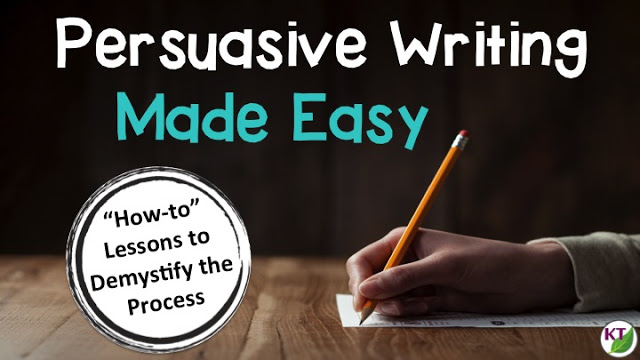
Persuasive / Argumentative Writing Pain Points
When you read your students’ essays, what are the pain points? For me, the list went like this:
– Lack of organization
– Inattention to audience and opposing views
– Weak opening and closing paragraphs
If you follow my blog, you’ve probably heard me reference (more than once) the error of assigning rather than teaching . I apologize for the repetition; if it wasn’t so important to recognize the difference, I could leave it alone. I feel compelled to admit when I’ve made this error myself, and this is another example where I assumed my students knew more than they did. Because I assigned an essay with little-to-no instruction, I yielded the unfortunate results of my poor investment when it came time to grade these essays.
After what probably was far too long a time, I realized I had made too many assumptions on background knowledge. What would someone who knew nothing about persuasive essays, maybe even persuasion of any kind, need to know in order to be s successful writer?
I identified what I consider critical skills for writing solid persuasive essays. To my view, the cherry-on-top skills like voice, word choice, sentence variety, fluency, etc. are part of the revision process, which follow lessons on structure and are not unique to this genre. What I first needed to focus on were the structural components necessary to properly write for the genre.
Skills You MUST Teach for Persuasive / Argumentative Writing:
– Consider your audience
– Take a position
– Address opposing views
– Outline the essay & draft body paragraphs
– Create opening paragraphs with an engaging hook the reader and thesis statement
– Create closing paragraphs that link to the opening and include a call to action
Armed with this list, I found that when I broke down each of these skills for isolated lessons and practice, the students’ writing improved dramatically. The problem is that we often skip steps due to the things we lack: time, a thorough curriculum or understanding of the process ourselves.
Or sometimes, we the hope that because students read, they’ll know how to write, almost by osmosis. There are no shortcuts. When we skip a critical step, we always have to circle back to teach it later. It really is more efficient and effective to invest the time up front.
Below, you’ll find how I think about each piece and my approach in teaching each component to make the persuasive writing process easier on you and your students!
If I’m honest, I probably went years without really teaching my students how to evaluate their audience prior to writing, at least in any meaningful way. I suppose I thought they would inherently understand that the arguments used to persuade a peer would differ from those to persuade a parent; and indeed, some students do come to you with that understanding, but you can’t rely on it.
Teaching Ideas
One idea here is to come up with a persuasive essay prompt (e.g. students should join organized sports) and several different audiences (doctors, parents, peers, teachers). Have students suggest a few reasons it might be good to let students to participate in organized sports.
Make a chart with the reasons in the rows and the audiences in the columns. Have students rate how convincing/motivating the reasons are for each particular group (see slide below). This will highlight for the students that considering the audience is important because each group has different factors they care about and that concern them.

Sample Slide from Audience Presentation
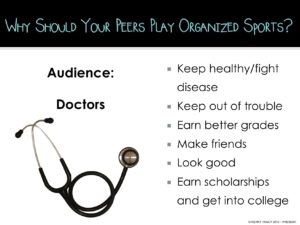
Audience Analysis Sample Slide
For additional practice, put students in groups. Give each the same prompt or a new one (students should be allowed to have cell phones in school), but a give each group a different audience (peers, parents, teachers, administrators). Have each group generate a list of motivating factors for their group. Come together whole-class to compare/contrast the lists.
Want a copy of my Audience Lesson? It’s a perk of being subscribed!
Take a Position, Make an Outline, Address Opposing Views, & Draft Body Paragraphs
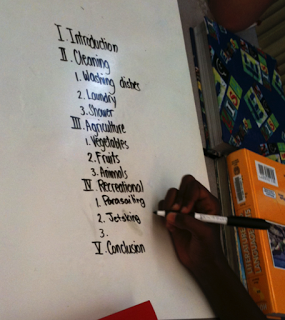
When students receive an essay prompt in which they can choose their own side, they sometimes get stuck because they think they must first choose. If they aren’t immediately drawn to one side, it can cause problems. I ask students, even if they think they know where they stand, to make a pros & cons list. This approach is serving double duty. First, it helps them see which side they have more ideas for, making it easier to choose a side. Second, it provides the opposing views that they will need to address in order to have an effective persuasive essay.
With the pros & cons and a position selected, the students move on to breaking down their outlines . I teach students to insert the cons in related body paragraphs or to use to help create a hook in the opening paragraph.
Opening & Closing Paragraphs
Without a doubt, opening and closing paragraphs can be a beast! A solid opening and closing can make or break an essay, so it’s important to spend time practicing. When your students master this skill, it will pay off year after year, so remember that when you’re in the weeds!
There is no one right way, but I choose to teach these paragraphs formulaically. I let students know along the way there are other ways to do this well, you don’t always have to be this structured, but I liken it to being a chef: first you learn how to cook by following a recipe, and eventually that gives way to you adding your own spices and flavors!
Opening paragraph requirements:
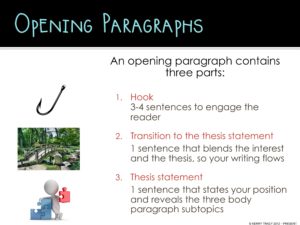
Sample Slide from Opening Paragraphs Presentation
- Transition to thesis statement
- Thesis statement
I usually start with the thesis statement since the students have just completed their outlines. The thesis statement should show what position the writer has taken and the topics of the body paragraphs to come.
Next, I teach three choices to create a hook: ask questions, anecdotes, and interesting facts/statistics. Here’s where the prep work comes in: you must craft an example of each type of hook for the same essay prompt (this is included in my individual and unit lessons).
Finally, I post the hook and the thesis statement with a large space in between. I ask the students to help me craft a transition to thesis that blends the two sections together. The trick is to keep it simple. It should be one true statement about your topic that doesn’t steal the thunder from your body paragraph ideas.
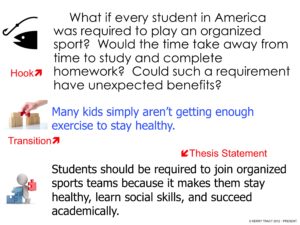
Opening Paragraph Example. It’s not perfect, but it’s a solid draft!
Closing paragraph requirements:
- Connect to the hook in the opening paragraph
- Re-state the thesis
- Call to action
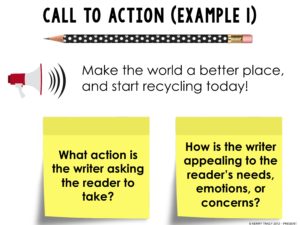
Call to Action Example
Good news! The three examples of hooks you used for the opening paragraph lessons will be used again in this lesson. You will need to show students how to connect back to the hook without introducing new (especially conflicting) information for each approach.
Next, re-word the thesis so it isn’t an exact repetition of what was used in the opening paragraph, but conveys the same information.
Finally, teach students to conclude by telling their reader what they should think or do next.
Final Notes
Giving students compelling prompts is important, and you can find inspiration in absolutely any controversy. Not sure what to do? Look to a problem in your school, community, or country. It’s often helpful to have a short discussion/debate on a topic to help students think of and flesh out ideas.
You’ve got this! You can not only survive teaching writing , but thrive! Not convinced? Try my No/Low prep. Persuasive Writing Unit. It comes with editable PowerPoint lessons, student notes, practice handouts, and more. Watch the video preview below for more details or click through to the Persuasive Writing unit !
Get All the Lessons, Ready-Made & Editable!
Take Me to the Unit!
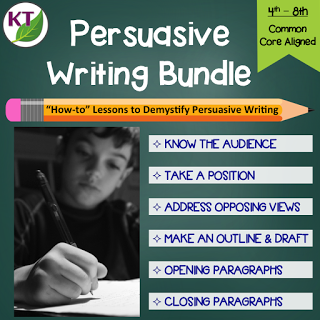
You might also want to check out these other writing posts:
Do Your Students Love to Write? It’s Within Reach
6 Ways to Survive Teaching Writing
Teaching Writing: Shacks vs. Mansions
PIN FOR LATER
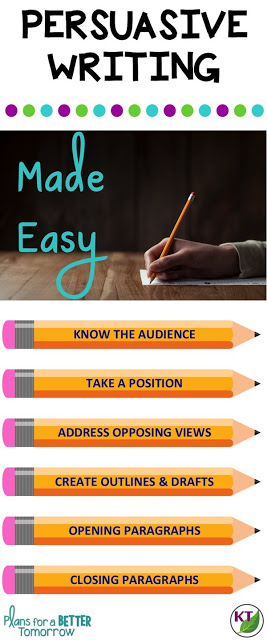
March 20, 2017 at 12:18 pm
Teaching writing can be difficult but I love the way you break down the process for your students! Thanks for sharing!
March 20, 2017 at 12:20 pm
Great post, assigning vs. teaching is definitely an error we all make at times!!
March 21, 2017 at 12:57 am
You have touched on something teachers often do – we get excited to introduce something and don't take the time to build the foundation. It has taken me a while, but like you, I've had to slow down and get the basics in place in order for anything of value to come from those kids who are learning!
March 21, 2017 at 3:06 am
Great job laying out the process!
- Easy STEM Activities in 30 Minutes or Less
- 5 Amazing Apple STEM Activities for Back to School STEM, Fall STEM, Apple Week STEM or Anytime STEM!
- Back-to-School Ice Breaker
- Top 10 Reasons to Start the School Year with STEM Challenges


- school Campus Bookshelves
- menu_book Bookshelves
- perm_media Learning Objects
- login Login
- how_to_reg Request Instructor Account
- hub Instructor Commons
- Download Page (PDF)
- Download Full Book (PDF)
- Periodic Table
- Physics Constants
- Scientific Calculator
- Reference & Cite
- Tools expand_more
- Readability
selected template will load here
This action is not available.

6.4: Persuasive Essays
- Last updated
- Save as PDF
- Page ID 107782

- Kathryn Crowther et al.
- Georgia Perimeter College via GALILEO Open Learning Materials
Writing a Persuasive Essay
Choose a topic that you feel passionate about. If your instructor requires you to write about a specific topic, approach the subject from an angle that interests you. Begin your essay with an engaging introduction. Your thesis should typically appear somewhere in your introduction. Be sure to have a clear thesis that states your position and previews the main points your essay will address.
Start by acknowledging and explaining points of view that may conflict with your own to build credibility and trust with your audience. Also state the limits of your argument. This too helps you sound more reasonable and honest to those who may naturally be inclined to disagree with your view. By respectfully acknowledging opposing arguments and conceding limitations to your own view, you set a measured and responsible tone for the essay.
Make your appeals in support of your thesis by using sound, credible evidence. Use a balance of facts and opinions from a wide range of sources, such as scientific studies, expert testimony, statistics, and personal anecdotes. Each piece of evidence should be fully explained and clearly stated. Make sure that your style and tone are appropriate for your subject and audience. Tailor your language and word choice to these two factors, while still being true to your own voice.
Finally, write a conclusion that effectively summarizes the main argument and reinforces your thesis. See the sample persuasive essay at the end of this section, “The Value of Technical High Schools in Georgia’s Business Marketplace,” by student Elizabeth Lamoureux. Please note that this essay uses the MLA style of documentation, for which you can find guidelines at Purdue University’s Online Writing Lab (OWL) website: http://owl.english.purdue.edu .
Sample Persuasive Essay
In this student paper, the student makes a persuasive case for the value of technical high schools in Georgia. As you read, pay attention to the different persuasive devices the writer uses to convince us of her position. Also note how the outline gives a structure to the paper that helps lead the reader step-by-step through the components of the argument.
Student Outline
Elizabeth Lamoureux
English 1101 Honors
April 25, 2013
Thesis : Technical high schools should be established in every county in Georgia because they can provide the technical training that companies need, can get young people into the workforce earlier, and can reduce the number of drop outs.
- Education can focus on these specific technical fields.
- Education can work with business to fill these positions.
- Apprenticeship programs can be a vital part of a student’s education.
- Apprenticeship programs are integral to Germany’s educational program, providing a realistic model for technical high schools in Georgia.
- Students train during their high school years for their chosen profession.
- Students begin to work in a profession or trade where there is a need.
- Students will become independent and self-supporting at the age of eighteen when many of their peers are still dependent upon their parents.
- Students can make more money over the course of their lifetimes.
- Students are more motivated to take courses in which they have an interest.
- Students will find both core and specialized classes more interesting and valuable when they can see the practical application of the subjects.
- Students would be able to earn a living wage while still taking classes that would eventually lead to full-time employment.
- Students would learn financial skills through experience with money management.
Student Essay
The Value of Technical High Schools in Georgia’s Business Marketplace
Businesses need specialized workers; young people need jobs. It seems like this would be an easy problem to solve. However, business and education are not communicating with each other. To add to this dilemma, emphasis is still put on a college education for everyone. Samuel Halperin, study director of the Commission on Work, Family, and Citizenship for the W. T. Grant Foundation, co-authored two reports: “The Forgotten Half: Non-College Youth in America” and “The Forgotten Half: Pathways to Success for America’s Youth and Young Families.” Halperin states: “While the attention of the nation was focused on kids going to college . . . the truth is that 70 percent of our adults never earn a college degree” (qtd. in Rogers). According to an article in Issues in Science and Technology, the Bureau of Labor Statistics projects that there will be more need for skills obtained through “community colleges, occupational training, and work experience” (Lerman). As Anne C. Lewis points out, although the poor job situation is recognized as detrimental to American youth, President Bush tried to get rid of career and technical education (CTE) and “promote strictly academic programs.” Luckily, Congress did not support it (Lewis 5). The figure for U.S. teen joblessness in October 2009 was 27.6 percent, the highest since World War II (Karaim). According to Thomas E. Persing, Americans are “disregarding the 50 percent who enter college and fail to graduate. . . .” Since everyone does not want or need to go to college, young people need an alternative choice, namely, technical high schools. Technical high schools should be established in every county in Georgia because they can provide the technical training that companies need, can get young people into the work force earlier, and can reduce the number of drop outs.
Technical high schools provide students with the technical training that companies need. By getting input from businesses on exactly what their specialized needs are, school systems could adapt their curricula to accommodate the needs of businesses. According to an article in Issues in Science and Technology, “employers report difficulty in recruiting workers with adequate skills.” The article goes on to say that “the shortage of available skills is affecting their ability to serve customers, and 84% of the firms say that the K-12 school system is not doing a good job preparing students for the workplace” (Lerman). Education can work with businesses to provide them with the workforce they need, and students can learn the skills they need through apprenticeship programs.
Business can be further involved by providing these apprenticeship programs, which can be a vital part of a student’s education. Currently, Robert Reich, economist and former Secretary of Labor, and Richard Riley, Secretary of Education, have spoken up for apprenticeship programs (Persing). In these programs, not only do students learn job-specific skills, but they also learn other skills for success in the work place, such as “communication, responsibility, teamwork, allocating resources, problem-solving, and finding information” (Lerman). Businesses complain that the current educational system is failing in this regard and that students enter the workforce without these skills.
The United States could learn from other countries. Apprenticeship programs are integral to Germany’s educational program, for example. Because such large numbers of students in a wide array of fields take advantage of these programs, the stigma of not attending college is reduced. Timothy Taylor, the Conversable Economist, explains that most German students complete this program and still have the option to pursue a postsecondary degree. Many occupations are represented in this program, including engineering, nursing, and teaching. Apprenticeship programs can last from one to six years and provide students with a wage for learning. This allows both business and student to compete in the market place. According to Julie Rawe, “under Germany’s earn-while-you-learn system, companies are paying 1.6 million young adults to train for about 350 types of jobs. . . .”
A second important reason technical high schools should be promoted in Georgia is that they prepare students to enter the work force earlier. Students not interested in college enter the work force upon high school graduation or sooner if they have participated in an apprenticeship or other cooperative program with a business. Students train during their high school years for their chosen profession and often work for the company where they trained. This ensures that students begin to work in a profession or trade where there is a need.
Another positive factor is that jobs allow students to earn a living upon graduation or before. Even though students are considered adults at eighteen, many cannot support themselves. The jobs available to young people are primarily minimum wage jobs which do not provide them with enough resources to live independently. One recent study indicates that the income gap is widening for young people, and “In March 1997, more than one-fourth of out-ofschool young adults who were working full-time were earning less than the poverty line income standard of just over $16,000 annually for a family of four” (“The Forgotten Half Revisited”). Conversely, by entering the work force earlier with the skills businesses need, young people make more money over their lifetimes. Robert I. Lerman considers the advantages:
Studies generally find that education programs with close links to the world of work improve earnings. The earnings gains are especially solid for students unlikely to attend or complete college. Cooperative education, school enterprises, and internship or apprenticeship increased employment and lowered the share of young men who are idle after high school.
Young people can obviously profit from entering the work force earlier.
One of the major benefits of promoting technical high schools in Georgia is that they reduce the number of dropouts. According to an article in the Atlanta Journal-Constitution, the figure for dropouts for the Atlanta metro area is about thirty-four percent (McCaffrey and Badertscher A16). The statistic for Germany’s dropout rate is less than nine percent (Rawe). As Rawe maintains, students stay in school because they cannot get the job if they do not have the diploma. Beyond the strong incentive of a job, students are more motivated to take courses in which they have an interest. In addition to the specialized career classes, students are still required to take core classes required by traditional high schools. However, practical application of these subjects makes them more interesting and more valuable to the students.
Another reason students drop out is to support their families. By participating in a program in which they are paid a wage and then entering that job full time, they no longer need to drop out for this reason. It is necessary for many students to contribute financially to the family: by getting a job earlier, they can do this. Joining the work force early also provides students with financial skills gained through experience with money management.
The belief of most Americans that everyone needs to have a college education is outdated. The United States needs skilled employees at all levels, from the highly technical to the practical day to day services society needs to sustain its current standard of living. Germany is doing this through its apprenticeship programs which have proven to be economically successful for both businesses and workers. If the State of Georgia put technical high schools in every county, businesses would get employees with the skills they need; young people would get into good paying jobs earlier, and schools would have fewer dropouts.
Works Cited
“The Forgotten Half Revisited: American Youth and Young Families, 1988-2008.” American Youth Policy Forum . N.p., n.d. Web. 21 Apr. 2012.
Karaim, Reed. “Youth Unemployment.” CQ Global Researcher 6 Mar. 2012: 105-28. Web. 21 Apr. 2012.
Lerman, Robert I. “Building a Wider Skills Net for Workers: A Range of Skills Beyond Conventional Schooling Are Critical to Success in the Job Market, and New Educational Approaches Should Reflect These Noncognitive Skills and Occupational Qualifications.” Issues in Science and Technology 24.4 (2008): 65+. Gale Opposing Viewpoints in Context . Web. 21 Apr. 2012.
Lewis, Anne C. “Support for CTE.” Tech Directions 65.3 (2005): 5-6. Academic Search Complete. Web. 11 Apr. 2012.
McCaffrey, Shannon, and Nancy Badertscher. “Painful Truth in Grad Rates.” Atlanta Journal-Constitution 15 Apr. 2012: A1+. Print.
Persing, Thomas E. “The Role of Apprenticeship Programs.” On Common Ground . Yale-New Haven Teachers Institute, Fall 1994. Web. 16 Apr. 2012.
Rawe, Julie. “How Germany Keeps Kids From Dropping Out.” Time Magazine U.S. Time Magazine, 11 Apr. 2006. Web. 16 Apr. 2012.
Rogers, Betsy. “Remembering the ‘Forgotten Half.’” Washington University in St. Louis Magazine Spring 2005. Web. 21 Apr. 2012.
Taylor, Timothy. “Apprenticeships for the U.S. Economy.” Conversableeconomist.blogspot.com. Conversable Economist , 18 Oct. 2011. Web. 16 Apr. 2012.

Writing a Persuasive Essay
Persuasive essays convince readers to accept a certain perspective. Writing a persuasive essay therefore entails making an argument that will appeal to readers, so they believe what you say has merit. This act of appealing to readers is the art of persuasion, also known as rhetoric. In classical rhetoric, persuasion involves appealing to readers using ethos, pathos, and logos.
In this tutorial, we refer to the sample persuasive draft and final paper written by fictional student Maggie Durham.
THE ART OF PERSUASION
Ethos refers to establishing yourself as a credible source of information. To convince an audience of anything, they must first trust you are being earnest and ethical. One strategy to do this is to write a balanced discussion with relevant and reliable research that supports your claims. Reliable research would include quoting or paraphrasing experts, first-hand witnesses, or authorities. Properly citing your sources, so your readers can also retrieve them, is another factor in establishing a reliable ethos. When writing for academic purposes, expressing your argument using unbiased language and a neutral tone will also indicate you are arguing fairly and with consideration of others having differing views.
When you appeal to your readers’ emotions, you are using pathos. This appeal is common in advertising that convinces consumers they lack something and buying a certain product or service will fulfill that lack. Emotional appeals are subtler in academic writing; they serve to engage a reader in the argument and inspire a change of heart or motivate readers toward a course of action. The examples you use, how you define terms, any comparisons you draw, as well as the language choices you use can draw readers in and impact their willingness to go along with your ideas.
Consider that one purpose of persuasion is to appeal to those who do not already agree with you, so it will be important to show that you understand other points of view. You will also want to avoid derogatory or insulting descriptions or remarks about the opposition. You wouldn’t want to offend the very readers you want to persuade.
Establishing an appeal of logos is to write a sound argument, one that readers can follow and understand. To do this, the facts and evidence you use should be relevant, representative, and reliable, and the writing as a whole should be well organized, developed, and edited.
STEPS FOR WRITING PERSUASIVELY
Step one: determine the topic.
The first step in writing a persuasive essay is to establish the topic. The best topic is one that interests you. You can generate ideas for a topic by prewriting, such as by brainstorming whatever comes to mind, recording in grocery-list fashion your thoughts, or freewriting in complete sentences what you know or think about topics of interest.
Whatever topic you choose, it needs to be:
- Interesting : The topic should appeal both to you and to your intended readers.
- Researchable : A body of knowledge should already exist on the topic.
- Nonfiction : The information about the topic should be factual, not based on personal opinions or conspiracy theories.
- Important : Your reader should think the topic is relevant to them or worthy of being explored and discussed.
Our sample student Maggie Durham has selected the topic of educational technology. We will use Maggie’s sample persuasive draft and final paper as we discuss the steps for writing a persuasive essay.
Step Two: Pose a Research Question
Once you have a topic, the next step is to develop a research question along with related questions that delve further into the first question. If you do not know what to ask, start with one of the question words: What? Who? Where? When? Why? and How? The research question helps you focus or narrow the scope of your topic by identifying a problem, controversy, or aspect of the topic that is worth exploration and discussion. Some general questions about a topic would be the following:
- Who is affected by this problem and how?
- Have previous efforts or polices been made to address this problem? – What are they?
- Why hasn’t this problem been solved already?
For Maggie’s topic of educational technology, potential issues or controversies range from data privacy to digital literacy to the impact of technology on learning, which is what Maggie is interested in. Maggie’s local school district has low literacy rates, so Maggie wants to know the following:
- Are there advantages and/or disadvantages of technology within primary and secondary education?
- Which types of technology are considered the best in terms of quality and endurance?
- What types of technology and/or programs do students like using and why?
- Do teachers know how to use certain technologies with curriculum design, instruction, and/or assessment?
Step Three: Draft a Thesis
A thesis is a claim that asserts your main argument about the topic. As you conduct your research and draft your paper, you may discover information that changes your mind about your thesis, so at this point in writing, the thesis is tentative. Still, it is an important step in narrowing your focus for research and writing.
The thesis should
1. be a complete sentence,
2. identify the topic, and
3. make a specific claim about that topic.
In a persuasive paper, the thesis is a claim that someone should believe or do something. For example, a persuasive thesis might assert that something is effective or ineffective. It might state that a policy should be changed or a plan should be implemented. Or a persuasive thesis might be a plea for people to change their minds about a particular issue.
Once you have figured out your research question, your thesis is simply the answer. Maggie’s thesis is “Schools should supply technology aids to all students to increase student learning and literacy rates.” Her next step is to find evidence to support her claim.
Step Four: Research
Once you have a topic, research question, and thesis, you are ready to conduct research. To find sources that would be appropriate for an academic persuasive essay, begin your search in the library. The Purdue Global Library has a number of tutorials on conducting research, choosing search teams, types of sources, and how to evaluate information to determine its reliability and usefulness. Remember that the research you use will not only provide content to prove your claim and develop your essay, but it will also help to establish your credibility as a reliable source (ethos), create a logical framework for your argument (logos), and appeal to your readers emotionally (pathos).
Step Five: Plan Your Argument; Make an Outline
Once you have located quality source information—facts, examples, definitions, knowledge, and other information that answers your research question(s), you’ll want to create an outline to organize it. The example outline below illustrates a logical organizational plan for writing a persuasive essay. The example outline begins with an introduction that presents the topic, explains the issue, and asserts the position (the thesis). The body then provides the reasoning for the position and addresses the opposing viewpoints that some readers may hold. In your paper, you could modify this organization and address the opposing viewpoints first and then give the reasoning for your viewpoints, or you can alternate and give one opposing viewpoint then counter that with your viewpoint and then give another opposing viewpoint and counter that with your viewpoint.
The outline below also considers the alternatives to the position—certainly, there are other ways to think about or address the issue or situation. Considering the alternatives can be done in conjunction with looking at the opposing viewpoints. You do not always have to disagree with other opinions, either. You can acknowledge that another solution could work or another belief is valid. However, at the end of the body section, you will want to stand by your original position and prove that in light of all the opposing viewpoints and other perspectives, your position has the most merit.
Sample Outline of a Persuasive Argument
- 1. Introduction: Tell them what you will tell them.
- a. Present an interesting fact or description to make the topic clear and capture the reader’s attention.
- b. Define and narrow the topic using facts or descriptions to illustrate what the situation or issue is (and that is it important).
- c. Assert the claim (thesis) that something should be believed or done about the issue. (Some writers also briefly state the reasons behind this claim in the thesis as Maggie does in her paper when she claims that schools should supply tablets to students to increase learning , engagement, and literacy rates ).
- 2. Body: Tell them.
- a. Defend the claim with logical reasons and practical examples based on research.
- b. Anticipate objections to the claim and refute or accommodate them with research.
- c. Consider alternate positions or solutions using examples from research.
- d. Present a final point based on research that supports your claim in light of the objections and alternatives considered.
- 3. Conclusion: Tell them what you told them.
- a. Recap the main points to reinforce the importance of the issue.
- b. Restate the thesis in new wording to reinforce your position.
- c. Make a final remark to leave a lasting impression, so the reader will want to continue this conversation and ideally adopt the belief or take the action you are advocating.
In Maggie’s draft, she introduced the topic with facts about school ratings in Texas and then narrowed the topic using the example of her local school district’s literacy rates. She then claimed the district should provide each student a tablet in order to increase learning (and thus, literacy rates).
Maggie defends her claim with a series of examples from research that proved how access to tablets, technology-integrated curriculums, and “flipped classrooms” have improved literacy rates in other districts. She anticipates objections to her proposal due to the high cost of technology and counter argues this with expert opinions and examples that show partnerships with businesses, personalized curriculums that technology makes possible, and teacher training can balance the costs. Maggie included an alternative solution of having students check out tablets from the library, but her research showed that this still left students needing Wi-Fi at home while her proposal would include a plan for students to access Wi-Fi.
Maggie concluded her argument by pointing out the cost of not helping the students in this way and restated her thesis reaffirming the benefits, and then left the reader with a memorable quote.
Click here to see Maggie’s draft with feedback from her instructor and a peer. Sample Persuasive Draft
Feedback, Revision, and Editing
After you write a draft of your persuasive essay, the next step is to have a peer, instructor, or tutor read it and provide feedback. Without reader feedback, you cannot fully know how your readers will react to your argument. Reader feedback is meant to be constructive. Use it to better understand your readers and craft your argument to more appropriately appeal to them.
Maggie received valuable feedback on her draft from her instructor and classmate. They pointed to where her thesis needed to be even more specific, to paragraphs where a different organization would make her argument more convincing, to parts of the paper that lacked examples, sentences that needed revision and editing for greater clarity, and APA formatting that needed to be edited.
Maggie also took a critical look at her paper and looked back at her writing process. One technique she found helpful was to read her paper aloud because it let her know where her wording and organization were not clear. She did this several times as she revised and again as she edited and refined her paper for sentence level clarity and concision.
In the end, Maggie produced a convincing persuasive essay and effective argument that would appeal to readers who are also interested in the way technology can impact and improve student learning, an important topic in 2014 when this paper was written and still relevant today.
Click here to see Maggie’s final draft after revising and editing. Sample Persuasive Revised
Share this:
- Click to email a link to a friend (Opens in new window)
- Click to share on Facebook (Opens in new window)
- Click to share on Reddit (Opens in new window)
- Click to share on Twitter (Opens in new window)
- Click to share on LinkedIn (Opens in new window)
- Click to share on Pinterest (Opens in new window)
- Click to print (Opens in new window)
Follow Blog via Email
Enter your email address to follow this blog and receive email notifications of new posts.
Email Address
- RSS - Posts
- RSS - Comments
- COLLEGE WRITING
- USING SOURCES & APA STYLE
- EFFECTIVE WRITING PODCASTS
- LEARNING FOR SUCCESS
- PLAGIARISM INFORMATION
- FACULTY RESOURCES
- Student Webinar Calendar
- Academic Success Center
- Writing Center
- About the ASC Tutors
- DIVERSITY TRAINING
- PG Peer Tutors
- PG Student Access
Subscribe to Blog via Email
Enter your email address to subscribe to this blog and receive notifications of new posts by email.
- College Writing
- Using Sources & APA Style
- Learning for Success
- Effective Writing Podcasts
- Plagiarism Information
- Faculty Resources
- Tutor Training
Twitter feed

How to Write Perfect Persuasive Essays in 5 Simple Steps
WHAT IS A PERSUASIVE ESSAY?

A persuasive text presents a point of view around a topic or theme that is backed by evidence to support it.
The purpose of a persuasive text can be varied. Maybe you intend to influence someone’s opinion on a specific topic, or you might aim to sell a product or service through an advertisement.
The challenge in writing a good persuasive text is to use a mix of emotive language and, in some cases, images that are supported by hard evidence or other people’s opinions.
In a persuasive essay or argument essay, the student strives to convince the reader of the merits of their opinion or stance on a particular issue. The student must utilise several persuasive techniques to form a coherent and logical argument to convince the reader of a point of view or to take a specific action.
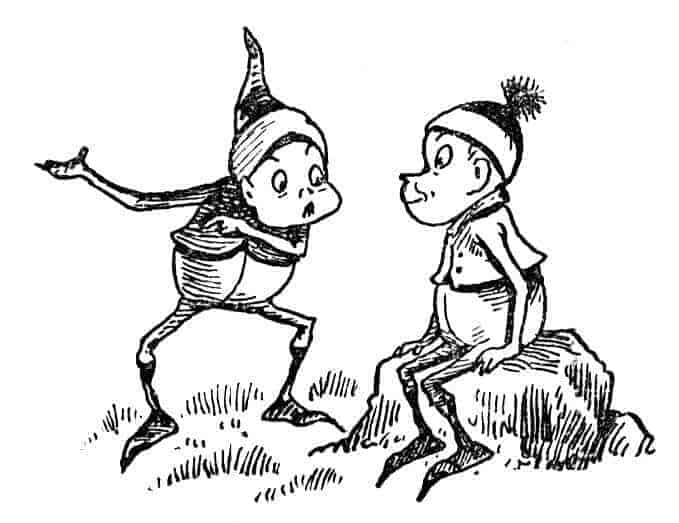
PERSUADING PEOPLE REQUIRES A CONSISTENT APPROACH…
Persuasive texts are simple in structure. You must clearly state your opinion around a specific topic and then repeatedly reinforce your opinions with external facts or evidence. A robust concluding summary should leave little doubt in the reader’s mind. ( Please view our planning tool below for a detailed explanation. )
TYPES OF PERSUASIVE TEXT
We cover the broad topic of writing a general persuasive essay in this guide, there are several sub-genres of persuasive texts students will encounter as they progress through school. We have complete guides on these text types, so be sure to click the links and read these in detail if required.
- Argumentative Essays – These are your structured “Dogs are better pets than Cats” opinion-type essays where your role is to upsell the positive elements of your opinions to your audience whilst also highlighting the negative aspects of any opposing views using a range of persuasive language and techniques.
- Advertising – Uses persuasive techniques to sell a good or service to potential customers with a call to action.
- Debating Speeches – A debate is a structured discussion between two teams on a specific topic that a moderator judges and scores. Your role is to state your case, sell your opinions to the audience, and counteract your opposition’s opinions.
- Opinion Articles, Newspaper Editorials. – Editorials often use more subtle persuasive techniques that blur the lines of factual news reporting and opinions that tell a story with bias. Sometimes they may even have a call to action at the end.
- Reviews – Reviews exist to inform others about almost any service or product, such as a film, restaurant, or product. Depending on your experiences, you may have firm opinions or not even care that much about recommending it to others. Either way, you will employ various persuasive techniques to communicate your recommendations to your audience.
- Please note a DISCUSSION essay is not a traditional persuasive text, as even though you are comparing and contrasting elements, the role of the author is to present an unbiased account of both sides so that the reader can make a decision that works best for them. Discussions are often confused as a form of persuasive writing.
A COMPLETE TEACHING UNIT ON PERSUASIVE WRITING SKILLS
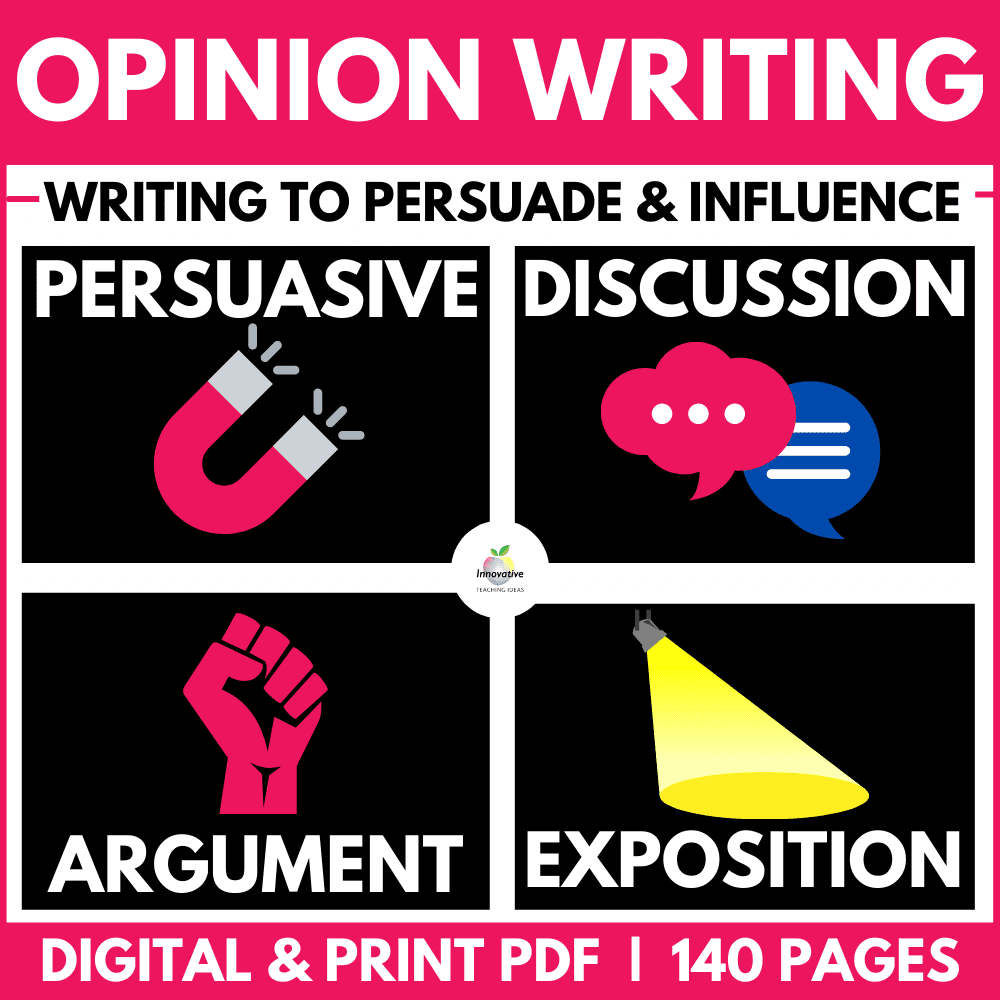
Teach your students to produce writing that PERSUADES and INFLUENCES thinking with this HUGE writing guide bundle covering: ⭐ Persuasive Texts / Essays ⭐ Expository Essays⭐ Argumentative Essays⭐ Discussions.
A complete 140 PAGE unit of work on persuasive texts for teachers and students. No preparation is required.
THE STRUCTURE OF A PERSUASIVE ESSAY

1. Introduction
In the introduction, the student will naturally introduce the topic. Controversial issues make for great topics in this writing genre. It’s a cliche in polite society to discourage discussions involving politics, sex, or religion because they can often be very divisive. While these subjects may not be the best topics of conversation for the dinner table at Thanksgiving, they can be perfect when deciding on a topic for persuasive writing. Obviously, the student’s age and abilities should be considered, as well as cultural taboos, when selecting a topic for the essay. But the point holds, the more controversial, the better.
Let’s take a look at some of the critical elements of the introduction when writing a persuasive essay:
Title: Tell your audience what they are reading.
This will often be posed as a question; for example, if the essay is on the merits of a vegetarian lifestyle, it may be called something like: To Eat Meat or Not?
Hook : Provide your audience with a reason to continue reading.
As with any genre of writing, capturing the reader’s interest from the outset is crucial. There are several methods of doing this, known as hooks. Students may open their essays with anecdotes, jokes, quotations, or relevant statistics related to the topic under discussion.
Background: Provide some context to your audience.
In this introductory section, students will provide the reader with some background on the topic. This will place the issue in context and briefly weigh some opinions on the subject.
Thesis statement: Let the audience know your stance.
After surveying the topic in the first part of the introduction, it is now time for the student writer to express their opinion and briefly preview the points they will make later in the essay.
2. Body Paragraphs
The number of paragraphs forming this essay section will depend on the number of points the writer chooses to make to support their opinion. Usually three main points will be sufficient for beginning writers to coordinate. More advanced students can increase the number of paragraphs based on the complexity of their arguments, but the overall structure will largely remain intact.
Be sure to check out our complete guide to writing perfect paragraphs here .
The TEEL acronym is valuable for students to remember how to structure their paragraphs. Read below for a deeper understanding.
Topic Sentence:
The topic sentence states the central point of the paragraph. This will be one of the reasons supporting the thesis statement made in the introduction.
These sentences will build on the topic sentence by illustrating the point further, often by making it more specific.
These sentences’ purpose is to support the paragraph’s central point by providing supporting evidence and examples. This evidence may be statistics, quotations, or anecdotal evidence.
The final part of the paragraph links back to the initial statement of the topic sentence while also forming a bridge to the next point to be made. This part of the paragraph provides some personal analysis and interpretation of how the student arrived at their conclusions and connects the essay as a cohesive whole.
3. Conclusion
The conclusion weaves together the main points of the persuasive essay. It does not usually introduce new arguments or evidence but instead reviews the arguments made already and restates them by summing them up uniquely. It is important at this stage to tie everything back to the initial thesis statement. This is the writer’s last opportunity to drive home their point, to achieve the essay’s goal, to begin with – persuade the reader of their point of view.

Ending an essay well can be challenging, but it is essential to end strongly, especially for persuasive essays. As with the hooks of the essay’s opening, there are many tried and tested methods of leaving the reader with a strong impression. Encourage students to experiment with different endings, for example, concluding the essay with a quotation that amplifies the thesis statement.
Another method is to have the student rework their ending in simple monosyllabic words, as simple language often has the effect of being more decisive in impact. The effect they are striving for in the final sentence is the closing of the circle.
Several persuasive writing techniques can be used in the conclusion and throughout the essay to amp up the persuasive power of the writing. Let’s take a look at a few.
ETHOS, PATHOS & LOGOS TUTORIAL VIDEO (2:20)
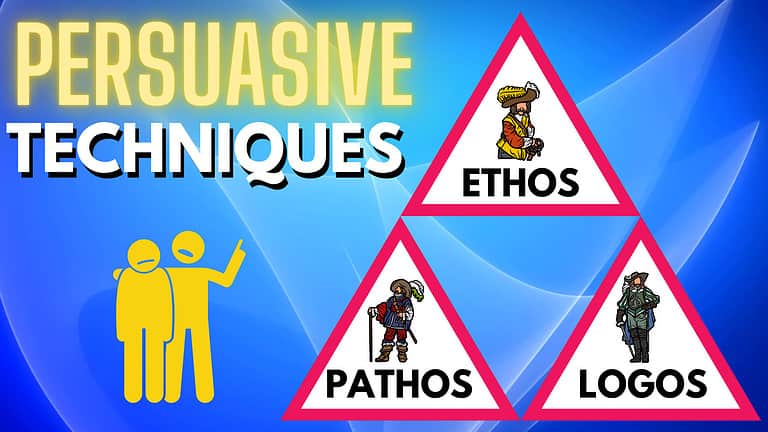
TIPS FOR WRITING A GREAT PERSUASIVE ESSAY


PERSUASIVE TECHNIQUES
In this article, we have outlined a basic structure that will be helpful to students in approaching the organization of their persuasive writing. It will also be helpful for the students to be introduced to a few literary techniques that will help your students to present their ideas convincingly. Here are a few of the more common ones:
Repetition: There is a reason why advertisements and commercials are so repetitive – repetition works! Students can use this knowledge to their advantage in their persuasive writing. It is challenging to get the reader to fully agree with the writer’s opinion if they don’t fully understand it. Saying the same thing in various ways ensures the reader gets many bites at the ‘understanding’ cherry.
Repetition Example: “The use of plastic bags is not only bad for the environment, but it is also bad for our economy. Plastic bags are not biodegradable, meaning they will not decompose and will continue to take up space in landfills. Plastic bags are also not recyclable, meaning they will not be reused and will instead end up in landfills. Plastic bags are not only bad for the environment, but they are also bad for our economy as they are costly to dispose of and take up valuable space in landfills.”
In this example, the phrase “not only bad for the environment but also bad for our economy” is repeated multiple times to reinforce the idea that plastic bags are not just a problem for the environment but also the economy. The repetition of the phrase emphasizes the point and makes it more persuasive.
It is also important to note that repetition could be used differently, such as repeating a word or phrase to create rhythm or emphasis.
Storytelling: Humans tend to understand things better through stories. Think of how we teach kids important values through time-tested fables like Peter and the Wolf . Whether through personal anecdotes or references to third-person experiences, stories help climb down the ladder of abstraction and reach the reader on a human level.
Storytelling Example: “Imagine you are walking down the street, and you come across a stray dog clearly in need of food and water. The dog looks up at you with big, sad eyes, and you cannot help but feel a twinge of compassion. Now, imagine that same scenario, but instead of a stray dog, it’s a homeless person sitting on the sidewalk. The person is clearly in need of food and shelter, and their eyes also look up at her with a sense of hopelessness.
The point of this story is to show that just as we feel compelled to help a stray animal in need, we should also feel compelled to help a homeless person. We should not turn a blind eye to the suffering of our fellow human beings, and we should take action to address homelessness in our community. It is important to remember that everyone deserves a roof over their head and a warm meal to eat. The story is designed to elicit an emotional response in the reader and make the argument more relatable and impactful.
By using storytelling, this passage creates an image in the reader’s mind and creates an emotional connection that can be more persuasive than just stating facts and figures.

Dissent: We live in a cynical age, so leaving out the opposing opinion will smack of avoidance to the reader. Encourage your students to turn to that opposing viewpoint and deal with those arguments in their essays .
Dissent Example: “Many people argue that students should not have to wear uniforms in school. They argue that uniforms stifle creativity and individuality and that students should be able to express themselves through their clothing choices. While these are valid concerns, I strongly disagree.
In fact, uniforms can actually promote individuality by levelling the playing field and removing the pressure to dress in a certain way. Furthermore, uniforms can promote a sense of community and belonging within a school. They can also provide a sense of discipline and structure, which can help to create a more focused and productive learning environment. Additionally, uniforms can save families money and eliminate the stress of deciding what to wear daily .
While some may argue that uniforms stifle creativity and individuality, the benefits of uniforms far outweigh the potential drawbacks. It is important to consider the impact of uniforms on the school as a whole, rather than focusing solely on individual expression.”
In this example, the writer presents the opposing viewpoint (uniforms stifle creativity and individuality) and then provides counterarguments to refute it. By doing so, the writer can strengthen their own argument and present a more convincing case for why uniforms should be worn in school.
A Call to Action: A staple of advertising, a call to action can also be used in persuasive writing. When employed, it usually forms part of the conclusion section of the essay and asks the reader to do something, such as recycle, donate to charity, sign a petition etc.
A quick look around reveals to us the power of persuasion, whether in product advertisements, newspaper editorials, or political electioneering; persuasion is an ever-present element in our daily lives. Logic and reason are essential in persuasion, but they are not the only techniques. The dark arts of persuasion can prey on emotion, greed, and bias. Learning to write persuasively can help our students recognize well-made arguments and help to inoculate them against the more sinister manifestations of persuasion.
Call to Action Example: “Climate change is a pressing issue that affects us all, and it’s important that we take action now to reduce our carbon footprint and protect the planet for future generations. As a society, we have the power to make a difference and it starts with small changes that we can make in our own lives.
I urge you to take the following steps to reduce your carbon footprint:
- Reduce your use of single-use plastics
- Use public transportation, carpool, bike or walk instead of driving alone.
- Support clean energy sources such as solar and wind power
- Plant trees and support conservation efforts
It’s easy to feel like one person can’t make a difference, but the truth is that every little bit helps. Together, we can create a more sustainable future for ourselves and for the planet.
So, let’s take action today and make a difference for a better future, it starts with minor changes, but it all adds up and can make a significant impact. We need to take responsibility for our actions and do our part to protect the planet.”
In this example, the writer gives a clear and specific call to action and encourages the reader to take action to reduce their carbon footprint and protect the planet. By doing this, the writer empowers the reader to take action and enables them to change.
Now, go persuade your students of the importance of perfecting the art of persuasive writing!
A COMPLETE UNIT ON TEACHING FACT AND OPINION
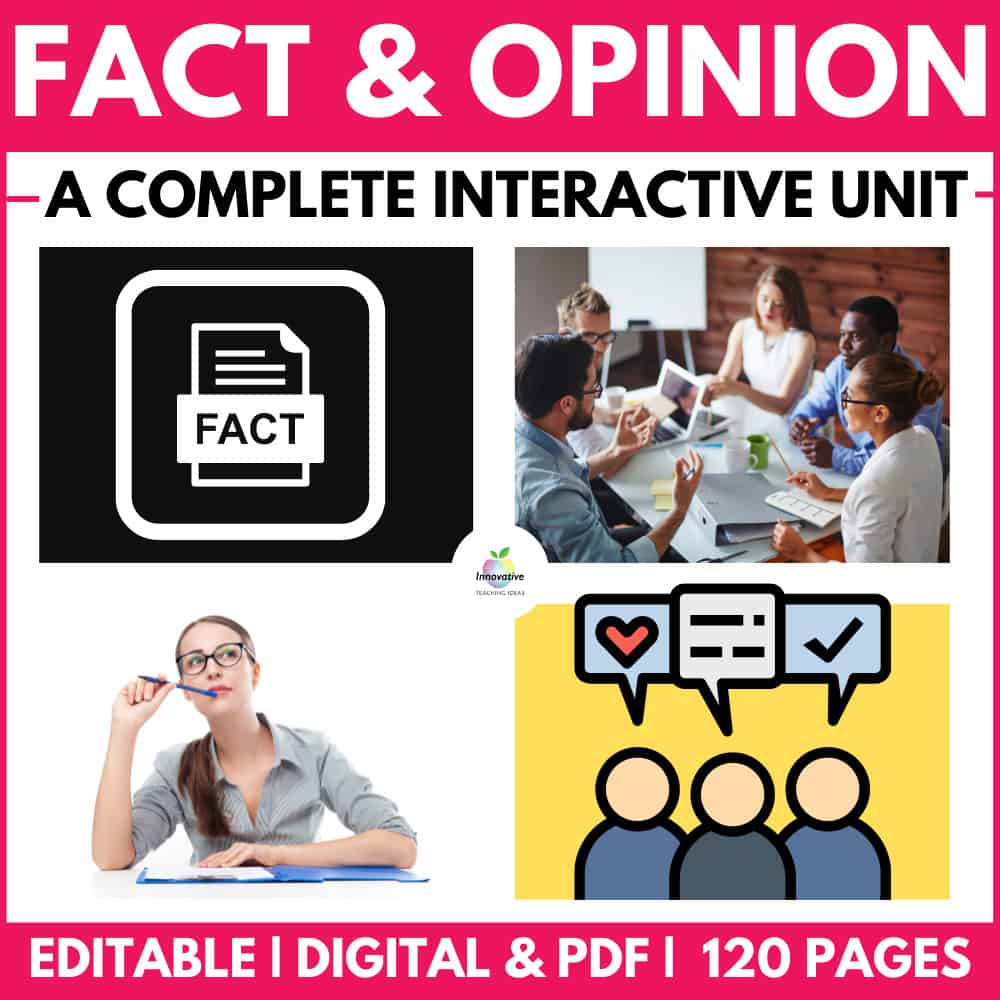
This huge 120-page resource combines four different fact and opinion activities that you can undertake as a WHOLE GROUP or as INDEPENDENT READING GROUP TASKS in either DIGITAL or PRINTABLE TASKS.
20 POPULAR PERSUASIVE ESSAY TOPICS FOR STUDENTS
Writing an effective persuasive essay demonstrates a range of skills that will be of great use in nearly all aspects of life after school.

In essence, if you can influence a person to change their ideas or thoughts on a given topic through how you structure your words and thoughts, you possess a very powerful skill.
Be careful not to rant wildly. Use facts and other people’s ideas who think similarly to you in your essay to strengthen your concepts.
Your biggest challenge in getting started may be choosing a suitable persuasive essay topic. These 20 topics for a persuasive essay should make this process a little easier.
- WHY ARE WE FASCINATED WITH CELEBRITIES AND WEALTHY PEOPLE ON TELEVISION AND SOCIAL MEDIA?
- IS IT RIGHT FOR SCHOOLS TO RAISE MONEY BY SELLING CANDY AND UNHEALTHY FOODS TO STUDENTS?
- SHOULD GIRLS BE ALLOWED TO PLAY ON BOYS SPORTING TEAMS?
- IS TEACHING HANDWRITING A WASTE OF TIME IN THIS DAY AND AGE?
- SHOULD THERE BE FAR GREATER RESTRICTIONS AROUND WHAT CAN BE POSTED ON THE INTERNET?
- SHOULD PROFESSIONAL ATHLETES HAVE TO TAKE DRUG TESTS?
- ARE TEENAGE PREGNANCY SHOWS A NEGATIVE OR POSITIVE INFLUENCE ON VIEWERS?
- SHOULD GAMBLING BE PROMOTED IN ANY WAY IN SPORTS EVEN THOUGH IT BRINGS IN LARGE AMOUNTS OF REVENUE?
- SHOULD SPORTING TEAMS THAT LOSE BE REWARDED BY RECEIVING INCENTIVES SUCH AS HIGH DRAFT PICKS AND / OR FINANCIAL BENEFITS?
- SHOULD SHARKS THAT ATTACK PEOPLE BE DESTROYED? SHOULD WE GET INVOLVED IN FOREIGN CONFLICTS AND ISSUES THAT DON’T DIRECTLY AFFECT OUR COUNTRY?
- SHOULD WE GET INVOLVED IN FOREIGN CONFLICTS AND ISSUES THAT DON’T DIRECTLY AFFECT OUR COUNTRY?
- COULD VIDEO GAMES BE CONSIDERED AS A PROFESSIONAL SPORT?
- IF YOU WERE THE LEADER OF YOUR COUNTRY AND HAD A LARGE SURPLUS TO SPEND, WHAT WOULD YOU DO WITH IT?
- WHEN SHOULD A PERSON BE CONSIDERED AND TREATED AS AN ADULT?
- SHOULD SMOKING BECOME AN ILLEGAL ACTIVITY?
- SHOULD THE VOTING AGE BE LOWERED?
- DOES PROTECTIVE PADDING IN SPORTS MAKE IT MORE DANGEROUS?
- SHOULD CELL PHONES BE ALLOWED IN THE CLASSROOM?
- IS TEACHING A FOREIGN LANGUAGE A WASTE OF TIME?
- SHOULD WE TEACH ETIQUETTE IN SCHOOLS?
PERSUASIVE PROMPTS FOR RELUCTANT WRITERS
If your students need a little more direction and guidance, here are some journal prompts that include aspects to consider.
- Convince us that students would be better off having a three-day weekend . There are many angles you could take with this, such as letting children maximize their childhood or trying to convince your audience that a four-day school week might actually be more productive.
- Which is the best season? And why? You will really need to draw on the benefits of your preferred season and sell them to your audience. Where possible, highlight the negatives of the competing seasons. Use lots of figurative language and sensory and emotional connections for this topic.
- Aliens do / or don’t exist? We can see millions of stars surrounding us just by gazing into the night sky, suggesting alien life should exist, right? Many would argue that if there were aliens we would have seen tangible evidence of them by now. The only fact is that we just don’t know the answer to this question. It is your task to try and convince your audience through some research and logic what your point of view is and why.
- Should school uniforms be mandatory? Do your research on this popular and divisive topic and make your position clear on where you stand and why. Use plenty of real-world examples to support your thoughts and points of view.
- Should Smartphones be banned in schools? Whilst this would be a complete nightmare for most students’ social lives, maybe it might make schools more productive places for students to focus and learn. Pick a position, have at least three solid arguments to support your point of view, and sell them to your audience.
VISUAL JOURNAL PROMPTS FOR PERSUASIVE WRITING
Try these engaging, persuasive prompts with your students to ignite the writing process . Scroll through them.

Persuasive Essay Examples (Student Writing Samples)
Below are a collection of persuasive essay samples. Click on the image to enlarge and explore them in greater detail. Please take a moment to read the persuasive texts in detail and the teacher and student guides highlight some of the critical elements of writing a persuasion.
Please understand these student writing samples are not intended to be perfect examples for each age or grade level but a piece of writing for students and teachers to explore together to critically analyze to improve student writing skills and deepen their understanding of persuasive text writing.
We recommend reading the example either a year above or below, as well as the grade you are currently working with, to gain a broader appreciation of this text type.
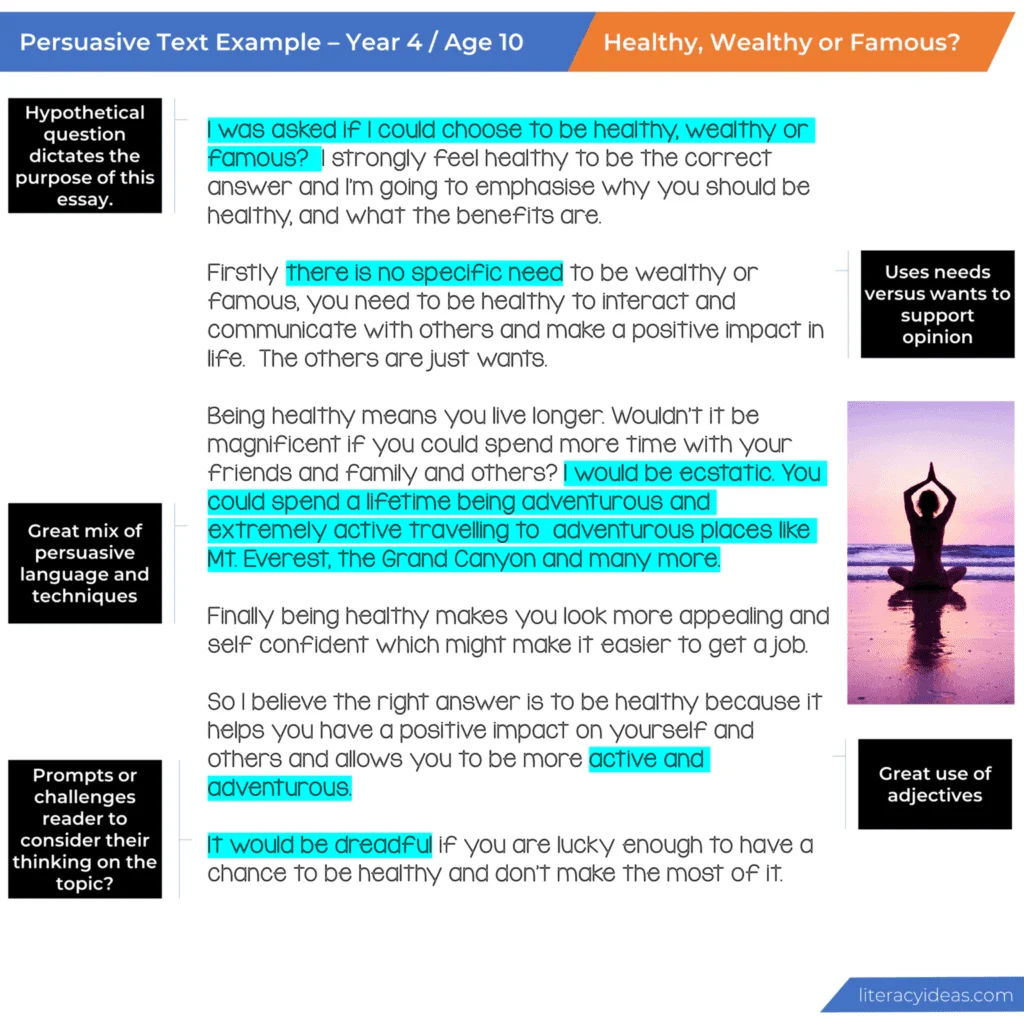
VIDEO TUTORIALS FOR PERSUASIVE WRITING

OTHER GREAT ARTICLES RELATED TO PERSUASIVE ESSAY WRITING

Teaching Resources
Use our resources and tools to improve your student’s writing skills through proven teaching strategies.
WHERE CAN I FIND A COMPLETE UNIT OF WORK ON HOW TO WRITE PERSUASIVE ESSAYS?

We pride ourselves on being the web’s best resource for teaching students and teachers how to write a persuasive text. We value the fact you have taken the time to read our comprehensive guides to understand the fundamentals of writing skills.
We also understand some of you just don’t have the luxury of time or the resources to create engaging resources exactly when you need them.
If you are time-poor and looking for an in-depth solution that encompasses all of the concepts outlined in this article, I strongly recommend looking at the “ Writing to Persuade and Influence Unit. ”
Working in partnership with Innovative Teaching Ideas , we confidently recommend this resource as an all-in-one solution to teach how to write persuasively.
This unit will find over 140 pages of engaging and innovative teaching ideas.
PERSUASIVE ESSAY WRITING CHECKLIST AND RUBRIC BUNDLE

⭐⭐⭐⭐⭐ (92 Reviews)
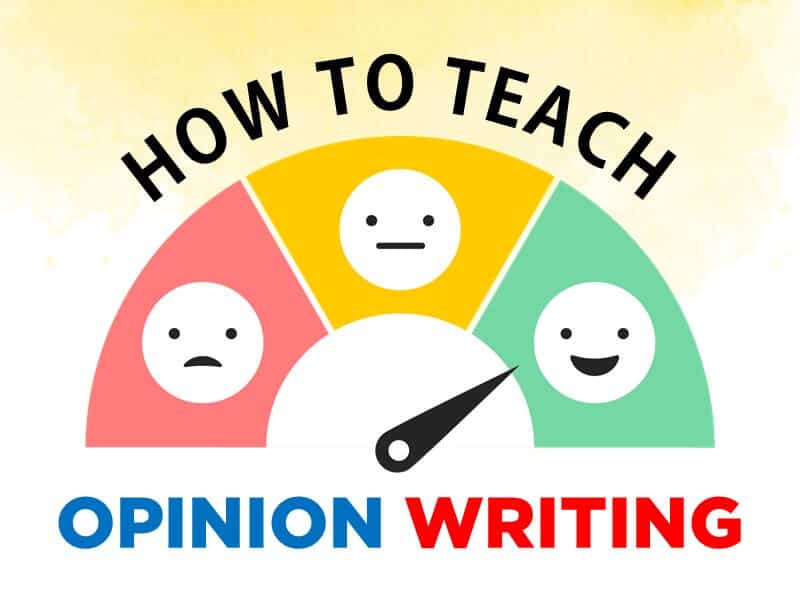
The Ultimate Guide to Opinion Writing for Students and Teachers
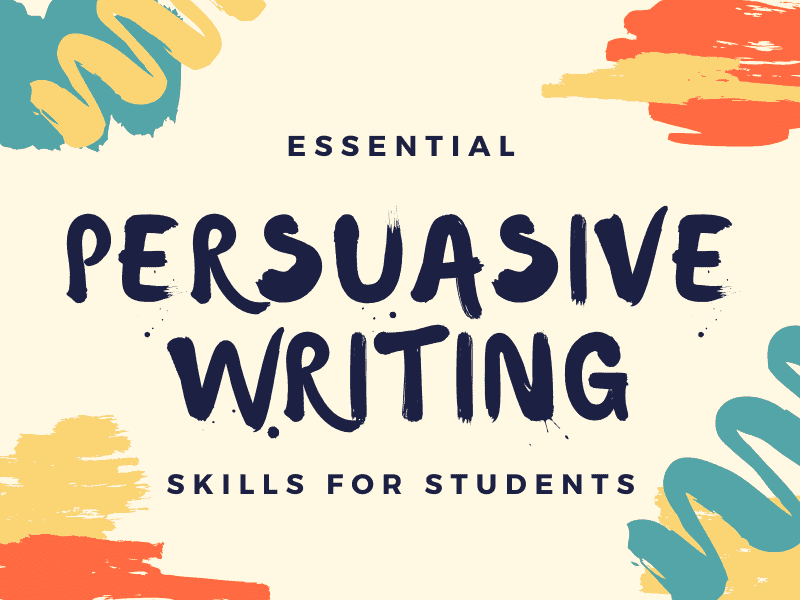
Top 5 Persuasive Writing Techniques for Students
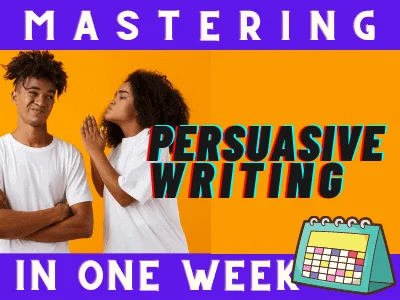
5 Top Persuasive Writing Lesson Plans for Students and Teachers
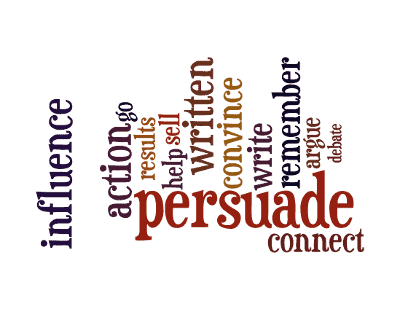
23 Persuasive writing Topics for High School students

How to Write an Advertisement: A Complete Guide for Students and Teachers
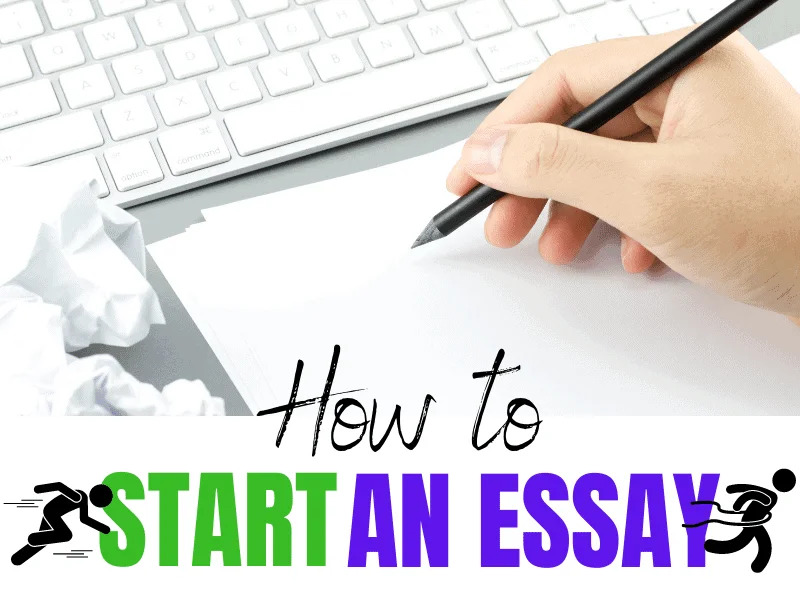
How to Start an Essay with Strong Hooks and Leads
- Share full article
Advertisement
Supported by
Writing curriculum
Argumentative Writing Unit
Writing prompts, lesson plans, webinars, mentor texts and a culminating contest, all to inspire your students to tell us what matters to them.

By The Learning Network
Unit Overview
On our site, we’ve been offering teenagers ways to tell the world what they think for over 20 years. Our student writing prompt forums encourage them to weigh in on current events and issues daily, while our contests have offered an annual outlet since 2014 for formalizing those opinions into evidence-based essays.
In this unit, we’re bringing together all the resources we’ve developed along the way to help students figure out what they want to say, and how to say it effectively.
Here is what this unit offers, but we would love to hear from both teachers and students if there is more we could include. Let us know in the comments, or by writing to [email protected].
Start With Our Prompts for Argumentative Writing
How young is too young to use social media? Should students get mental health days off from school? Is $1 billion too much money for any one person to have?
These are the kinds of questions we ask every day on our site. In 2017 we published a list of 401 Prompts for Argumentative Writing categorized to provoke thinking on aspects of contemporary life from social media to sports, politics, gender issues and school. In 2021, we followed it up with 300 Questions and Images to Inspire Argument Writing , which catalogs all our argument-focused Student Opinion prompts since then, plus our more accessible Picture Prompts.
Teachers tell us their students love looking at these lists, both to inspire their own writing and to find links to reliable sources about the issues that intrigue them. In fact, every year we get many contest submissions that grow directly out of these questions. Several, like this one , have even gone on to win.
But even if you’re not participating in our contest, you might use these prompts to invite the kind of casual, low-stakes writing that can help your students build skills — in developing their voices, making claims and backing them up with solid reasoning and evidence.
And, if your students respond to our most recent prompts by posting comments on our site, they can also practice making arguments for an authentic audience of fellow students from around the world. Each week we choose our favorites to honor in our Current Events Conversation column .
Find Lesson Plans on Every Aspect of Argument Writing
Over the years, we’ve published quite a few lesson plans to support our annual argument writing contests — so many, in fact, that we finally rounded them all up into one easy list.
In “ 10 Ways to Teach Argument-Writing With The New York Times ,” you’ll find resources for:
Exploring the role of a newspaper opinion section
Understanding the difference between fact and opinion
Analyzing the use of rhetorical strategies like ethos, pathos and logos
Working with claims, evidence and counterarguments
Helping students discover the issues that matter to them
Breaking out of the “echo chamber” when researching hot-button issues
Experimenting with visual argument-making
In 2021, we also developed An Argumentative-Writing Unit for Students Doing Remote Learning that can help teenagers guide their own learning.
Teach and Learn With Mentor Texts
You probably already know that you can find arguments to admire — and “writer’s moves” to emulate — all over the Times Opinion section . But have you thought about using the work of our previous Student Editorial Contest winners as mentor texts too?
Here are ways to use both:
Learn from the Op-Ed columnist Nicholas Kristof’s writing process : One edition of our “Annotated by the Author” Mentor Text series is by Mr. Kristof. See what he has to say about the writing challenges he faced in a recent column and how he did the kinds of things students will have to do, too, from fact-checking to fixing grammar errors to balancing storytelling with making a larger point.
Get to know one writer’s rhetorical style : Many teachers use an “adopt a columnist” method, inviting students to focus on the work of one of the Times Opinion columnists to get to know his or her issues and rhetorical style. In 2019, an English teacher in Connecticut wrote for our site about how he does this exercise, in which his students choose from among columnists at The Times, The Washington Post and The Wall Street Journal.
Use the work of teenage winners to help your students identify “writer’s moves” they can borrow: Teachers have told us there is no better way to prepare students to enter our contest than to have them examine the work of previous winners.
On our current site, you can find the essays of the top winners and the runners-up from 2017-202 3. Invite your students to read one and answer the questions we pose in all our Mentor Texts columns : “What do you notice or admire about this piece? What lessons might it have for your writing?” Then, have them borrow one or more of this student’s “writer’s moves” and imitate it in their own work.
We have also published two Learning Network books , one that collects 100 of the best student essays from this contest all in one place, categorized by subjects like “Teenage Life Online,” “Gender and Sexuality” and “Sports and Gaming,” and the other a related teacher’s guide to using them in the classroom.
Here is a roundup of ideas from 17 teachers and students for ways to use these “authentic, powerful and unafraid” student essays in several classroom contexts.
Finally, two new entries in our Annotated by the Author series feature student editorial contest winners from 2020 discussing their work and sharing tips: Ananya Udaygiri on “How Animal Crossing Will Save the World” and Abel John on “Collar the Cat!”
Get Practical Tips From Our Related Videos and Webinars

The video above, “ How to Write an Editorial ,” is only three minutes long, but in it Andy Rosenthal, the former editor of the Times Opinion page, gives students seven great pieces of advice.
Both students and teachers are welcome to watch our popular on-demand 2017 webinar, “ Write to Change the World: Crafting Persuasive Pieces With Help From Nicholas Kristof and the Times Op-Ed Page ,” which includes a wealth of practical tips from Mr. Kristof, as well as from Kabby Hong, a Wisconsin English teacher who works with this contest annually, and his student, Daina Kalnina, whose 2017 essay was one of our top winners that year.
Finally, you can watch our 2021 on-demand webinar, Teaching Argumentative Writing , that focuses on two key steps in the process: finding your argument, and using evidence to support it. You will also get broad overview of how to use our writing prompts and the work of our student winners to help your own students find topics they care about, and craft solid arguments around them. You can also watch an edited version of this webinar below.
Enter Our New Student Open Letter Contest: March 13-April 17, 2024
The culmination of this unit? Our new Open Letter Contest.
An open letter is a published letter of protest or appeal usually addressed to an individual but intended for the general public. Martin Luther King’s Letter From Birmingham Jail , the recent letter signed by over 1,000 tech leaders about the dangers of A.I. and this funny 2020 letter addressed to Harry and Meghan are all examples of this rich tradition.
Just as we did for our long-running Editorial Contest, we invite students to make an argument in 450 words about something that matters to them, and persuade us that we should care, too. But this time, students must address themselves to a specific target audience or recipient, institution or group — one that has the power to make meaningful change.
Whether students choose their parents, teachers, school board members or mayor; a member of Congress; the head of a corporation; or a metonym like “Silicon Valley” or “The Kremlin,” they should ask themselves, What do I care about? Who can make changes, big or small, local or global, to address my issue or problem? What specifically do I want them to understand and do? And how can I write this as an “open letter,” meaningful not just to me and the recipient, but to a general audience?
More information will be published soon. Until then, you can find ideas and inspiration in our related writing unit and via the work of past Editorial winners .
As always, all student work will be read by our staff, volunteers from the Times Opinion section, and/or by educators from around the country. Winners will have their work published on our site and, perhaps, in the print New York Times.
- Features for Creative Writers
- Features for Work
- Features for Higher Education
- Features for Teachers
- Features for Non-Native Speakers
- Learn Blog Grammar Guide Community Events FAQ
- Grammar Guide
How to Write a Persuasive Essay: Tips and Tricks

Allison Bressmer

Most composition classes you’ll take will teach the art of persuasive writing. That’s a good thing.
Knowing where you stand on issues and knowing how to argue for or against something is a skill that will serve you well both inside and outside of the classroom.
Persuasion is the art of using logic to prompt audiences to change their mind or take action , and is generally seen as accomplishing that goal by appealing to emotions and feelings.
A persuasive essay is one that attempts to get a reader to agree with your perspective.
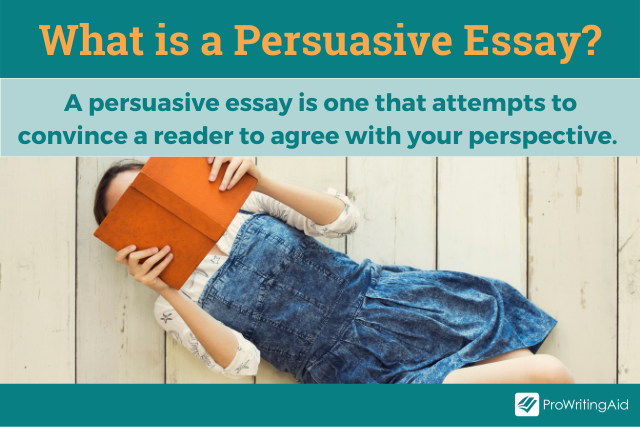
Ready for some tips on how to produce a well-written, well-rounded, well-structured persuasive essay? Just say yes. I don’t want to have to write another essay to convince you!
How Do I Write a Persuasive Essay?
What are some good topics for a persuasive essay, how do i identify an audience for my persuasive essay, how do you create an effective persuasive essay, how should i edit my persuasive essay.
Your persuasive essay needs to have the three components required of any essay: the introduction , body , and conclusion .
That is essay structure. However, there is flexibility in that structure.
There is no rule (unless the assignment has specific rules) for how many paragraphs any of those sections need.
Although the components should be proportional; the body paragraphs will comprise most of your persuasive essay.
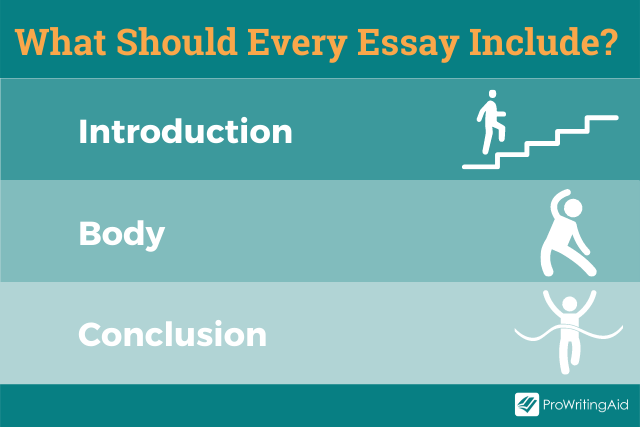
How Do I Start a Persuasive Essay?
As with any essay introduction, this paragraph is where you grab your audience’s attention, provide context for the topic of discussion, and present your thesis statement.
TIP 1: Some writers find it easier to write their introductions last. As long as you have your working thesis, this is a perfectly acceptable approach. From that thesis, you can plan your body paragraphs and then go back and write your introduction.
TIP 2: Avoid “announcing” your thesis. Don’t include statements like this:
- “In my essay I will show why extinct animals should (not) be regenerated.”
- “The purpose of my essay is to argue that extinct animals should (not) be regenerated.”
Announcements take away from the originality, authority, and sophistication of your writing.
Instead, write a convincing thesis statement that answers the question "so what?" Why is the topic important, what do you think about it, and why do you think that? Be specific.
How Many Paragraphs Should a Persuasive Essay Have?
This body of your persuasive essay is the section in which you develop the arguments that support your thesis. Consider these questions as you plan this section of your essay:
- What arguments support your thesis?
- What is the best order for your arguments?
- What evidence do you have?
- Will you address the opposing argument to your own?
- How can you conclude convincingly?
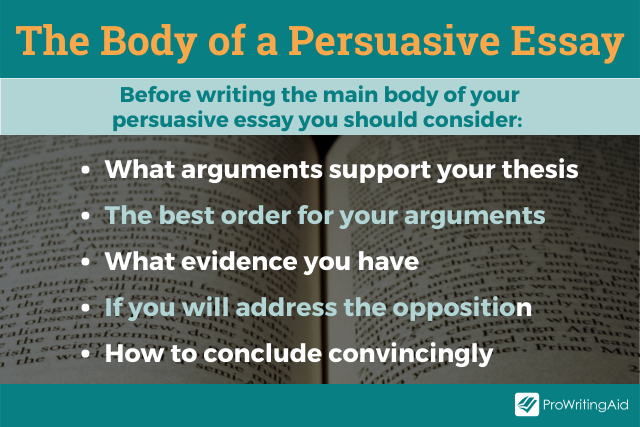
TIP: Brainstorm and do your research before you decide which arguments you’ll focus on in your discussion. Make a list of possibilities and go with the ones that are strongest, that you can discuss with the most confidence, and that help you balance your rhetorical triangle .
What Should I Put in the Conclusion of a Persuasive Essay?
The conclusion is your “mic-drop” moment. Think about how you can leave your audience with a strong final comment.
And while a conclusion often re-emphasizes the main points of a discussion, it shouldn’t simply repeat them.
TIP 1: Be careful not to introduce a new argument in the conclusion—there’s no time to develop it now that you’ve reached the end of your discussion!
TIP 2 : As with your thesis, avoid announcing your conclusion. Don’t start your conclusion with “in conclusion” or “to conclude” or “to end my essay” type statements. Your audience should be able to see that you are bringing the discussion to a close without those overused, less sophisticated signals.
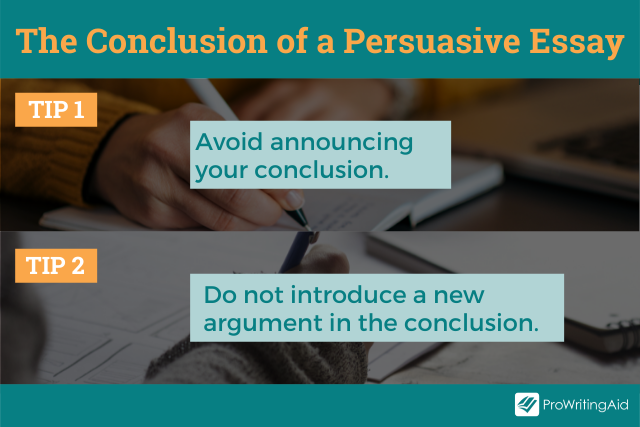
If your instructor has assigned you a topic, then you’ve already got your issue; you’ll just have to determine where you stand on the issue. Where you stand on your topic is your position on that topic.
Your position will ultimately become the thesis of your persuasive essay: the statement the rest of the essay argues for and supports, intending to convince your audience to consider your point of view.
If you have to choose your own topic, use these guidelines to help you make your selection:
- Choose an issue you truly care about
- Choose an issue that is actually debatable
Simple “tastes” (likes and dislikes) can’t really be argued. No matter how many ways someone tries to convince me that milk chocolate rules, I just won’t agree.
It’s dark chocolate or nothing as far as my tastes are concerned.
Similarly, you can’t convince a person to “like” one film more than another in an essay.
You could argue that one movie has superior qualities than another: cinematography, acting, directing, etc. but you can’t convince a person that the film really appeals to them.
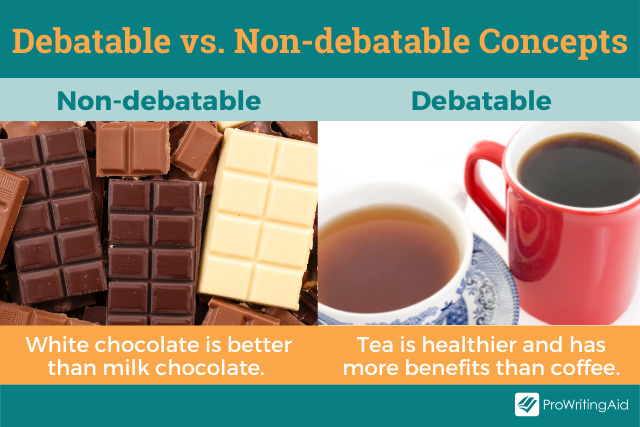
Once you’ve selected your issue, determine your position just as you would for an assigned topic. That position will ultimately become your thesis.
Until you’ve finalized your work, consider your thesis a “working thesis.”
This means that your statement represents your position, but you might change its phrasing or structure for that final version.
When you’re writing an essay for a class, it can seem strange to identify an audience—isn’t the audience the instructor?
Your instructor will read and evaluate your essay, and may be part of your greater audience, but you shouldn’t just write for your teacher.
Think about who your intended audience is.
For an argument essay, think of your audience as the people who disagree with you—the people who need convincing.
That population could be quite broad, for example, if you’re arguing a political issue, or narrow, if you’re trying to convince your parents to extend your curfew.
Once you’ve got a sense of your audience, it’s time to consult with Aristotle. Aristotle’s teaching on persuasion has shaped communication since about 330 BC. Apparently, it works.
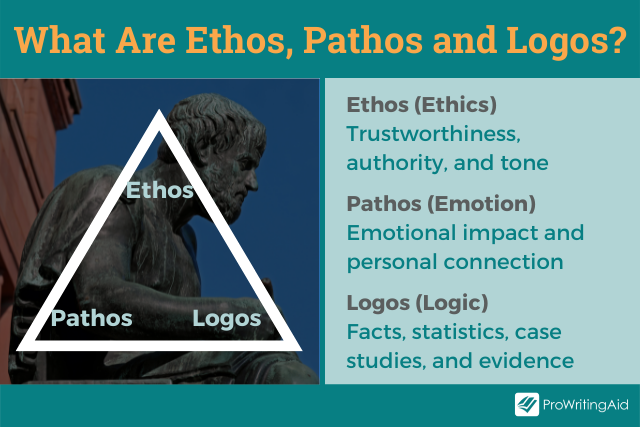
Aristotle taught that in order to convince an audience of something, the communicator needs to balance the three elements of the rhetorical triangle to achieve the best results.
Those three elements are ethos , logos , and pathos .
Ethos relates to credibility and trustworthiness. How can you, as the writer, demonstrate your credibility as a source of information to your audience?
How will you show them you are worthy of their trust?
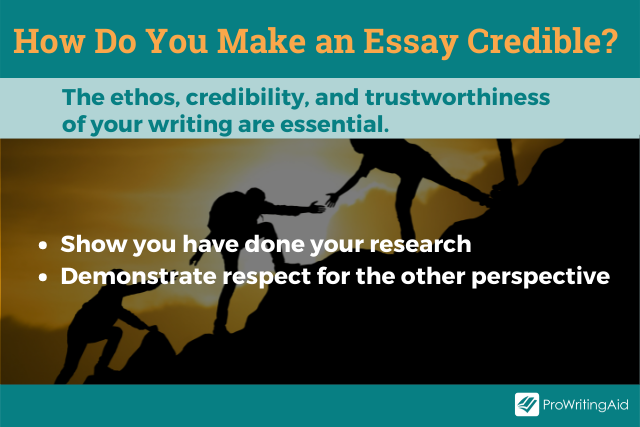
- You show you’ve done your research: you understand the issue, both sides
- You show respect for the opposing side: if you disrespect your audience, they won’t respect you or your ideas
Logos relates to logic. How will you convince your audience that your arguments and ideas are reasonable?
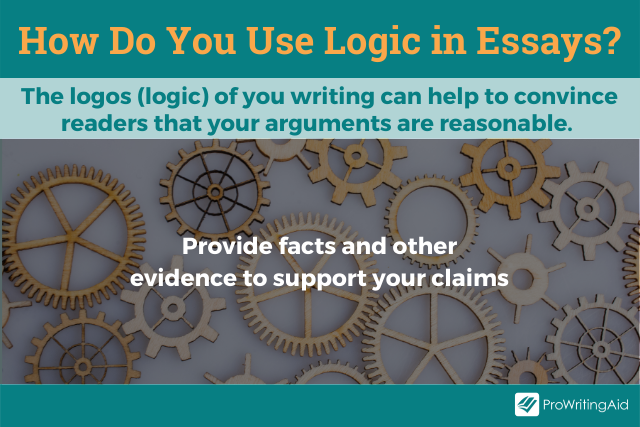
You provide facts or other supporting evidence to support your claims.
That evidence may take the form of studies or expert input or reasonable examples or a combination of all of those things, depending on the specific requirements of your assignment.
Remember: if you use someone else’s ideas or words in your essay, you need to give them credit.
ProWritingAid's Plagiarism Checker checks your work against over a billion web-pages, published works, and academic papers so you can be sure of its originality.
Find out more about ProWritingAid’s Plagiarism checks.
Pathos relates to emotion. Audiences are people and people are emotional beings. We respond to emotional prompts. How will you engage your audience with your arguments on an emotional level?
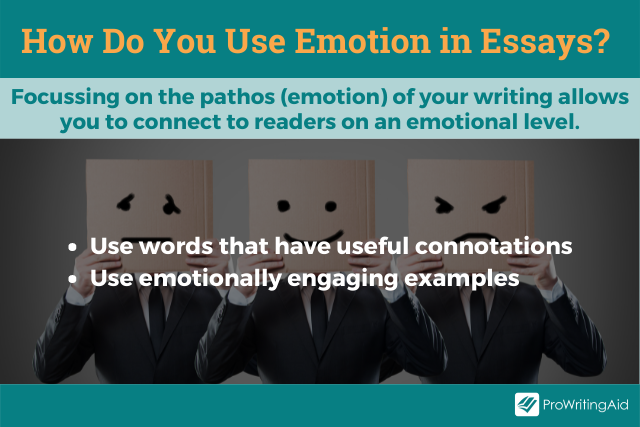
- You make strategic word choices : words have denotations (dictionary meanings) and also connotations, or emotional values. Use words whose connotations will help prompt the feelings you want your audience to experience.
- You use emotionally engaging examples to support your claims or make a point, prompting your audience to be moved by your discussion.
Be mindful as you lean into elements of the triangle. Too much pathos and your audience might end up feeling manipulated, roll their eyes and move on.
An “all logos” approach will leave your essay dry and without a sense of voice; it will probably bore your audience rather than make them care.
Once you’ve got your essay planned, start writing! Don’t worry about perfection, just get your ideas out of your head and off your list and into a rough essay format.
After you’ve written your draft, evaluate your work. What works and what doesn’t? For help with evaluating and revising your work, check out this ProWritingAid post on manuscript revision .
After you’ve evaluated your draft, revise it. Repeat that process as many times as you need to make your work the best it can be.
When you’re satisfied with the content and structure of the essay, take it through the editing process .
Grammatical or sentence-level errors can distract your audience or even detract from the ethos—the authority—of your work.
You don’t have to edit alone! ProWritingAid’s Realtime Report will find errors and make suggestions for improvements.
You can even use it on emails to your professors:
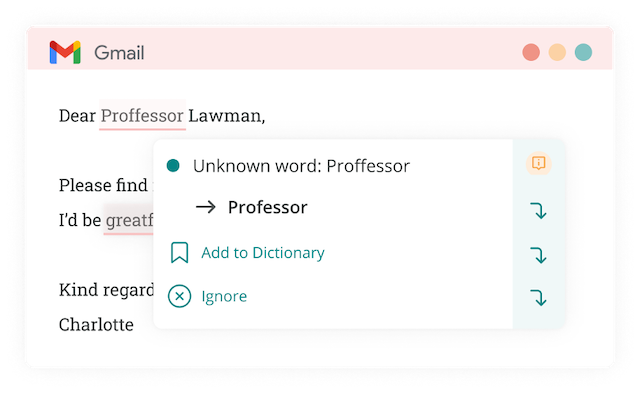
Try ProWritingAid with a free account.
How Can I Improve My Persuasion Skills?
You can develop your powers of persuasion every day just by observing what’s around you.
- How is that advertisement working to convince you to buy a product?
- How is a political candidate arguing for you to vote for them?
- How do you “argue” with friends about what to do over the weekend, or convince your boss to give you a raise?
- How are your parents working to convince you to follow a certain academic or career path?
As you observe these arguments in action, evaluate them. Why are they effective or why do they fail?
How could an argument be strengthened with more (or less) emphasis on ethos, logos, and pathos?
Every argument is an opportunity to learn! Observe them, evaluate them, and use them to perfect your own powers of persuasion.

Be confident about grammar
Check every email, essay, or story for grammar mistakes. Fix them before you press send.
Allison Bressmer is a professor of freshman composition and critical reading at a community college and a freelance writer. If she isn’t writing or teaching, you’ll likely find her reading a book or listening to a podcast while happily sipping a semi-sweet iced tea or happy-houring with friends. She lives in New York with her family. Connect at linkedin.com/in/allisonbressmer.
Get started with ProWritingAid
Drop us a line or let's stay in touch via :

- The Art of Persuasion – INQUIRY UNIT
by CristinaM. | Jul 15, 2021 | language and literature , planning , writing | 0 comments
As promised on Twitter for a while, I am posting an inquiry unit into persuasive writing that was also featured on Toddle . For the IB PYP teachers who use this platform in their schools you can find the planning, implementing and unit flow sections all complete (with explanations for teachers, student-friendly instructions, assessment tools as well as the materials – PDFs, GDocs etc.- I created for each phase).
NOTE: You can adapt any learning experience to suit your students age-group and skill. The inquiry unit is 6 weeks long and I focused on the language aspect – it is a stand-alone inquiry. If you do happen to have a unit on Media, for instance, as part of your IB curriculum and Program of Inquiry, you can incorporate this in parallel to the main unit (under How We Express Ourselves transdisciplinary theme).
Central Idea – Language can be used to influence our thinking, emotions, and behavior in many ways.
Learner Profile Attributes – Communicators, Open-minded
Key Concepts:
- Change – Students will understand that the structure, features, and techniques of persuasive communication change according to the audience, format, and purpose intended.
- Perspective – Students will understand that persuasive texts can be perceived differently and they are built based on specific perspectives.
- Function – Students will understand that persuasive communication has specific features, it involves the use of certain techniques, and is intended for different audiences.
Lines of Inquiry
- Features, forms, and techniques used in persuasive communication
- How persuasive communication works
- The impact of persuasive communication
Learning Goals and Success Criteria
Students will KNOW
- The main forms of persuasive texts (e.g. brochure, flyer, letter, book/film/product review, campaign ad, TV commercial, political speech, academic essay etc.)
- Figures of speech used in persuasive communication (e.g. onomatopoeia, hyperbole, personification etc.)
- Elements of design (color, shape, texture, position, alignment etc.)
- The main language features of a persuasive text (e.g. use of present tense and imperatives)
- The techniques used in persuasive communication (e.g. flattery, bandwagon, facts and statistics etc.)
Students will be able to DO
- Identify various elements in a persuasive text, verbal and non-verbal
- Write persuasive texts using language and design elements effectively
- Analyze the features of given persuasive texts
- Evaluate the effectiveness of various persuasive texts based on given criteria
- Discuss the importance of the target audience when creating a persuasive text (and how it influences the choice of language and design)
- Reflect on the effectiveness of their own and peers’ persuasive texts based on various criteria
Students will UNDERSTAND
- Persuasive communication is pervasive , all around us (on TV, online, in newspapers etc.)
- Language is essential in influencing emotions, thinking and behavior
- There is a wide range of persuasive techniques used in order to transmit a message
- The choice of persuasive tools (verbal and visual) depends on several factors such as audience (e.g. age), format (political speech vs. holiday brochure), and specific purpose (e.g. advertising a product or service vs. initiating a donation campaign)
1. PROVOCATION Tables
- Strategy : I See – I Think – I Wonder
- Student grouping: Groups of 3-4 (depending on class size)
- Time : 45-50 minutes
- Activity description :
- On the desks there are big sheets of paper where there are glued (in the center) different persuasive texts – a leaflet, a book review, an ad for a product, a section of a speech; one table will have 2-3 devices for students to play 1 commercial and 1 movie trailer
- The prompt on each table is I See – I Think – I Wonder. Students rotate between tables at the teacher’s clap (they move to a new table, jot down their answers, then move to the next).
- When the groups finish, the entire class is sitting in a half-circle and the teacher puts up on the whiteboard all A3 papers and has the commercial and movie trailers ready on the big screen.
- The conversation begins using the same three prompts. As students share their answers, the teacher jots down key words on the flipchart so that their thinking becomes visible to everyone. Eventually, some key concepts will be shared – “convince”, “sell”, “influence” etc.
- The teacher makes a donut-like shape, writing the main words in the concentric circle and the word “persuasion” in the center. Students are then encouraged to come up with a definition of the word – strategy: Turn and Talk.
- Wrap-up: The teacher clarifies the concept (“persuasion”) and puts up the PYP concepts FUNCTION, CHANGE and PERSPECTIVE. S/he will clarify the lines of inquiry (see planner) and invite students to explore persuasive communication around them for the next lesson. HOMEWORK :
- Observe where you find persuasive communication on the way to and from school, at home and places you go. Jot down some of them for discussion next time.
Resource: I see Think Wonder (PDF)
2. Discover, Uncover, Share
- Strategy : Chalk Talk
- Student grouping : Groups of 3-4 (depending on class size)
- Activity description:
- On the whiteboard there are two sections labeled: WHAT / WHERE (in a T-chart like form). Students are given post-its to share what they saw (e.g. a billboard) and where they saw it (e.g. on the way home, in the street).
- The teacher reads some of them and encourages students to add a brief verbal description.
- Students work in groups of 3-4 (depending on class size). Each group is given a large sheet of paper and a different color. The groups have the following prompts in the middle of each sheet:
- – What forms of persuasive communication did you see?
- – Where did you see persuasive communication?
- – Who might use this type of communication?
- – Why was persuasive communication used?
*These key questions address the main elements (genre, purpose, audience etc.). The students are given about 10 minutes to write their answers as a group. Then each group shares their thinking. This allows the class to engage in listening, speaking and learning about all groups’ tasks.
4. Wrap-up: The students are given 5 minutes to reflect on this learning experience using the prompt, “3-2-1: Three things that I learned/ Two things that I found important/ One question that I have.”
*The teacher collects their answers, and copies some of the more interesting questions they have for next time in the inquiry process.
RESOURCES: 3-2-1 Bridge , Group Questions
FINDING OUT
3. Zoom in- Zoom out
- Zoom in Chalk-Talk: Each group is given a sample of a persuasive text (a book review, an ad, a brochure, a speech). Each group has a chart with these column headings: PURPOSE / STRUCTURE / LANGUAGE / LAYOUT. They are given 10-15 minutes to complete the table.
- Gallery Walk : The student answers on the big sheet (together with the sample of text) are placed around the classroom. Each group is invited to “visit” and read other groups’ work. They can add comments or questions using post-its as they move from paper to paper.
- Zoom out The entire class is invited for a discussion. The students are encouraged to generalize based on the examples from each group. E.g. “Persuasive texts, regardless of their format, try to influence us.”, “Persuasion involves emotions, feelings and powerful visual or written messages.” etc.
- Ensure the students rotate quietly and read carefully other groups’ answers.
- In the final discussion, encourage students to generalize – not to refer to specific examples. These big ideas will serve as ways to consolidate their understanding of the Central Idea, which is placed in the center of the board.
RESOURCE: Zoom in – Zoom out
4. Let’s Analyze!
*A combination of explicit teaching and collaboration tasks follow so that students get familiar with specific types of persuasive techniques (key concept – FUNCTION).
- Strategy : Micro Lab
- The teacher puts up the concept Function and the respective line of inquiry. Then a big chart with major persuasive techniques and examples for each is shared. The students also have the same chart printed in small size (A4 papers). The teacher gives students time to go through each technique name (e.g. rule of three) and example given (e.g. “Are you exhausted, frustrated, and moody ? Then try RelaxOchair!”).
- Each group of students is given samples of brochures, ads etc. and they have to highlight where they found the given techniques. Identifying them correctly is the first step.
- Then the teacher puts cards on tables – a card with a device name (e.g. bandwagon) and an example. They are randomly placed – the task is for students to walk around and match them.
- Wrap-up: The class is invited to share their favorite technique and explain why, in their opinion, it is effective. EXIT TICKET (on a post-it): “Give your own 3 examples techniques you learned today. “
*The teacher collects the exit tickets and ensures that s/he will address in the next lesson any misconceptions that might occur based on student work (e.g. confusing hyperbole with loaded terms).
RESOURCES: Cards – Examples , Cards – Techniques , Exit Ticket – 3 Examples , FUNCTION (1) , Function
SORTING OUT
5. Let’s Rewrite!
- Students are given, in groups, samples of persuasive texts. Certain sentences and parts of sentences are highlighted already in the texts. Their task is to improve the respective parts by using other persuasive techniques (from the board).
- Each group shares their improved texts and then receives feedback from the peers on the effectiveness of their changes.
- Wrap-up discussion around the concept of CHANGE. Ask open-ended questions and record student ideas on the flipchart.
- How does the impact on the reader change if we modify certain words and phrases?
- What techniques seem more effective in this context? Would they work in another? Why/why not?
- How would we change the text if it was a specific audience? Say, teenagers compared to adults? etc.
RESOURCES: Let’s Rewrite – Text, Let’s Rewrite – Visuals
6. Audience Matters!
- The teacher gives each group a set of 4 different ads and a chart with these columns: Product / Audience / Language features / Design / Message intended. The students need to observe the ads and complete the chart.
- Each group shares their chart in front of the class.
- Whole class discussion follows around the concept of CHANGE. The teacher asks open-ended questions and as students answer s/he records main ideas on the flipchart:
- What did you notice about the type of products intended for each age group?
- How did the language used change? How is it similar / different for each audience?
- What colors, fonts and general use of design elements do you see?
- How was the message worded in each case? Why do you think that was different? etc.
- Ensure the ads given are printed on large A3 papers, in color, so that the students can notice all the details.
- Use more specific observation prompts where you see a group or a student has difficulty detailing certain features (e.g. font colors in the ad, position of the person in the ad – foreground, background; the size of the item advertised; use of light and negative space etc.).
RESOURCES: Audience Matters! (1)
*NOTE: From now on I am using the child-friendly language mentioned on Toddle.
- – layout
- – colors
- – fonts
- – language
- – message etc.
- – what was different in terms of the language used?
- – how did the choice of color enable you to transmit the message?
- – how could each audience use the iPad considering their age?
- – how sophisticated were the terms each group used in their advertisement based on the age of their audience? etc.
MAKING CONCLUSIONS
10. Pair-up to Persuade!
You did a great job as a class last time when we co-created a persuasive essay together! Now we go even further and work only with one partner so that we stretch our thinking and creativity more.
- View the PowerPoint presentation with a peer on your iPad. Pause, Talk, Jot – write down any key points you find important.
- Decide , together with your classmate, on a topic you want to write about. It could be something related to school (e.g. Persuading the school board to allow the use of mobile phones), to a broader cause (e.g. Persuading the city council to promote recycling in our city) etc.
- Use the structure given to write , together, a persuasive essay on the chosen topic.
- Share your essay with another pair of students. Read theirs, too. Give and receive feedback using the assessment criteria given.
RESOURCES: PERSUASIVE Writing , Persuasive Writing – 5-paragraph Essay , Pair Up to Persuade
11. Power-up YOUR Persuasive Voice!
Today we will be the sole creators of our essay! You will decide the topic, what techniques you want to use, and how you want to work (in your notebook, on the iPad etc.).
- Select one topic from the given list or decide your own.
- Draft your essay using key points, not full sentences (see template 1).
- Use template 2 and the vocabulary given to write your essay. Each time you use a word or a phrase cross it out from the list so you won’t repeat it.
- Exchange your essay with another classmate, read theirs and assess it using the criteria given. (S/he will do the same with your work.)
- On your exit ticket answer these two questions:
- What was most difficult in writing the essay?
- What would you improve about your essay next time?
NOTE: As students practice in the following days, remove some of the scaffolds in the template. Start with removing some phrases, then slowly remove the structure – students need to be able to write a persuasive essay without any support by the end of the unit.
RESOURCES: Draft – Template 1 , Power-Up YOUR Persuasive Voice , Persuasive Writing – 5-paragraph Essay
REFLECTING
12. Circle of Viewpoints
Now that we have quite a lot of knowledge and skill regarding persuasion techniques, let’s apply them in a different way. You are given this scenario:
“Climate change is a global issue that affects everyone. However, there are many perspectives on this for different reasons. Let’s discuss it from different viewpoints.
Imagine that new solar panels are to be built and placed in a rural (agricultural) area, near the farmers’ fields and close to a mining region. Each group will represent a “voice” (perspective) and will try to persuade the others about their viewpoint. The groups will be the following:
- Farmers (who might lose cultivating land in favor of the solar panels)
- Miners (who might lose their jobs since the area will use green energy)
- Local inhabitants (who will benefit from a lower energy cost and also less pollution)
- Businessmen (who want to implement this project and earn money)
- Mayor (who wants to be elected and needs to make the final decision)
- Wildlife activists (who worry that the solar panels will disrupt the migration of a unique species of small mammals that live in those fields)
- OBSERVERS (this group will notice the interactions between you, the use of arguments, the way you deliver the speech)
- In your group, outline the key arguments to support your particular cause.
- Collaboratively write a speech using persuasive text features and techniques.
- Sit in a circle with all groups. Take turns delivering your speech. In the meantime, the observers’ group will take notes and evaluate the effectiveness of your arguments and use of language.
- As a class, listen to the observers’ feedback. Comment on whether you agree or disagree with their evaluation, and specify your reasons.
- Reflect in your journals about this learning experience. Answer these 2 questions:
- What was challenging during this process
- What connections with real-life issues can you make?
RESOURCES: Persuasive Writing – 5-paragraph Essay , Circle of Viewpoints
- You may want to record the talk so that the students view the recording later and observe themselves and reflect on their use of presentation skills (body language, voice etc.).
- The follow-up should be another Circle of Viewpoints activity connected to your current inquiry unit (e.g. Migration, Government etc.). This would enable students to not only apply their persuasive communication skills but also the knowledge gained in the respective unit of inquiry.
13. Let’s Reflect…
We have been exploring the world of persuasive communication and looked at advertisements, commercials, speeches and more. We investigated the way language and design are used to influence us, and we applied persuasive techniques in a variety of activities.
Let’s reflect on our learning so far and then share our ideas and thoughts at the end.
- Use the reflection sheet to write your big ideas.
- Post your reflections around the classroom. We will have a Gallery Walk and read some of our peers’ reflections.
- Share your reflections using the Toddle Student App.
RESOURCES: PERSUASION – reflection
Share this:
- Click to share on Twitter (Opens in new window)
- Click to share on Facebook (Opens in new window)
- Click to share on LinkedIn (Opens in new window)
- Click to share on Reddit (Opens in new window)
- Click to share on Pinterest (Opens in new window)
- Click to share on Pocket (Opens in new window)
- Click to share on Telegram (Opens in new window)
- Click to share on WhatsApp (Opens in new window)
- Click to share on Tumblr (Opens in new window)
- Click to email a link to a friend (Opens in new window)
Leave a Reply Cancel reply
This site uses Akismet to reduce spam. Learn how your comment data is processed .
Recent Posts
- Strategy vs. Tactics: Planning, Assessment and Learning (3)
- Strategy vs. Tactics: Assessment, Planning, and Learning (2)
- Strategy vs. Tactics: Assessment, Planning, and Learning (1)
- Thinking: Shaken, not Stirred 2
- International
- Schools directory
- Resources Jobs Schools directory News Search

PERSUASIVE WRITING Unit for Y7-9 English
Subject: English
Age range: 11-14
Resource type: Unit of work
Last updated
16 November 2023
- Share through email
- Share through twitter
- Share through linkedin
- Share through facebook
- Share through pinterest

Introducing our comprehensive PERSUASIVE WRITING UNIT, designed to guide Secondary English students through the intricacies of persuasive language techniques and analysis.
Perfect for High School English students in Years 7-10 who are studying persuasive language and its impact on creating meaning.
This unit begins by covering the basics of persuasive writing before delving into a thorough analysis of persuasive language techniques. Students will follow step-by-step graphic organizers and exercises to develop their own persuasive essays.
Our ready-to-print student booklet accompanies teacher notes, a unit plan, and a marking schedule, providing a complete package that saves you time and energy.
Included in this persuasive writing unit:
A 25-page print-and-go student booklet that covers:
- An introduction to persuasive writing
- Key persuasive language terms
- The art of persuasion
- Analysis of a persuasive speech script
- Generation of persuasive topics
- Planning and writing pages, broken down into easily manageable steps
- Sample essay marking schedule
- Sample teaching plan
- Teacher keys
While originally created for Year 9 - Year 11 students in Australia and New Zealand, this versatile resource can be used worldwide for similar purposes. Simply adjust the marking schedule to complement your school system.
Please note that this product contains some British English spelling.
Let our PERSUASIVE WRITING UNIT do the work for you, providing a comprehensive and structured approach to teaching persuasive language techniques and analysis. Grab your copy today and watch your students’ persuasive writing skills flourish!
Tes paid licence How can I reuse this?
Your rating is required to reflect your happiness.
It's good to leave some feedback.
Something went wrong, please try again later.
This resource hasn't been reviewed yet
To ensure quality for our reviews, only customers who have purchased this resource can review it
Report this resource to let us know if it violates our terms and conditions. Our customer service team will review your report and will be in touch.
Not quite what you were looking for? Search by keyword to find the right resource:
Persuasive Writing Prompt, Essay Unit, Graphic Organizer - Watching Less TV

- Google Apps™
Also included in

Description
Introducing how to write a persuasive essay has never been easier! This persuasive writing prompt lesson guides students through a step-by-step processof writing a persuasive essay with a call-to-action. It includes a persuasive writing graphic organizer , rubric, persuasive writing quiz, and a persuasive writing outline . The topic of this resource is - Why Should People Watch Less TV?
All aspects of persuasive writing are covered in this resource: brainstorming ideas , developing a thesis statement , incorporating a call-to-action , introducing supporting evidence , writing hooks and leads , and incorporating the 6 Traits of Writing ™.
The video, slide show, graphic organizer, worksheets, writing template, and rubric allow students to practice and develop their persuasive writing skills. The writing quiz reinforces guided note-taking techniques when used in conjunction with the instructional video. The detailed lesson plans make implementing persuasive writing easy for teachers.
The lesson can be used in class, assigned for distance learning, or given as independent student work. The instructional video with writing tutorial and template can also be presented as whole class instruction or assigned for students to complete at home.
Each resource listed below is included in Google Drive™ and print format.
*****************************************************************************************
This Persuasive Writing Prompt lesson includes:
Entertaining Instructional Video with:
- Description of expository essay
- Requirements of expository writing
- Brainstorming ideas
- Prompt identification and comprehension
- Thesis statement development
- Rubric explanation
- How to Write a Persuasive Essay tutorial and writing template
- How to Write a Persuasive Essay writing quiz / guided note-taking
Detailed Lesson Plan with:
- Common Core State Standards Indicated on Lesson Plan
- Instructional Focus
- Instructional Procedures
- Objectives/Goals
- Direct Instruction
- Guided Practice
- Differentiation
- ESE Strategies
- ELL Strategies
- I Can Statement
- Essential Question
Persuasive Writing Prompt Worksheets with:
- Brainstorming section
PowerPoint Presentation with:
- Introduction slide with prompt (interactive for students to identify key vocabulary)
- Brainstorming slide (interactive for students to list ideas)
- Standard and implied thesis development slides
- How to Write a Persuasive Essay tutorial and writing template slides
- Checklist slide
Persuasive Writing Quiz
Persuasive Writing Rubric
Persuasive Writing Graphic Organizer
Google Slides ™
The lessons in the Middle School Persuasive Writing Prompts Bundle 2 include:
- Why Adopt Pets and Not Shop?
- How Can Bullying Be Stopped?
- How Should Cheating Be Handled?
- What Should Be in a Time Capsule?
- Should Schools Teach Cursive?
- Should Schools Fund Field Trips?
- Should Schools Give Homework?
- Why Should People Watch Less TV?
- Should Schools Offer Related Arts?
- What's the Ideal Superhero Power?
Plus a FREE Persuasive Writing Essay Lesson
- Should Kids Have Cell Phones?
Connect with me for the latest Write On! with Jamie news:
- Write On! with Jamie Blog
- FB Community for 6-12 ELA Teachers
. . . and visit my WRITE ON! with Jamie website for a free TEXT EVIDENCE WRITING LESSON!
© Google Inc.™ All rights reserved. Google™ and the Google Logo are registered trademarks of Google Inc.™ Write On! with Jamie® is an independent company and is not affiliated with or endorsed by Google Inc.™
Terms of Use
Copyright © Write On! with Jamie. All rights reserved by author. All components of this product are to be used by the original downloader only. Copying for more than one teacher, classroom, department, school, or school system is prohibited unless additional licenses are purchased. This product may not be distributed or displayed digitally for public view. Failure to comply is a copyright infringement and a violation of the Digital Millennium Copyright Act (DMCA). Clipart and elements found in this product are copyrighted and cannot be extracted and used outside of this file without permission or license. Intended for classroom and personal use ONLY.
Questions & Answers
Write on with jamie.
- We're hiring
- Help & FAQ
- Privacy policy
- Student privacy
- Terms of service
- Tell us what you think

Persuasive Writing
In this language arts unit, students learn how to “argue on paper” using a fictional case about a school dress code rule against band t-shirts. The lessons take them through the process of writing two persuasive essays: one supporting the rule and one opposing it. After the essays, we suggest having your class play the game Supreme Decision to see how these arguments relate to issues of freedom of speech in schools. Supreme Decision is an excellent fit with the language arts classroom because it requires reading comprehension and higher-order thinking skills in the application of rules and evaluation of arguments.
Lesson 1: So You Think You Can Argue

Lesson 2: I Can't Wear What??

Lesson 3: Lookin' for Evidence
Lesson 4: no rambling allowed, lesson 5: yeah, but..., lesson 6: the dreaded outline, lesson 7: emphasize, minimize, lesson 8: from outline... to essay, see how it all fits together.

IMAGES
VIDEO
COMMENTS
If you're a writing teacher in grades 7-12 and you'd like a classroom-ready unit like the one described above, including mini-lessons, sample essays, and a library of high-interest online articles to use for gathering evidence, take a look at my Argumentative Writing unit. Just click on the image below and you'll be taken to a page where you can read more and see a detailed preview of ...
Persuasion Map: Students can use this online interactive tool to map out an argument for their persuasive essay.: Persuasive Strategy Presentation: This handy PowerPoint presentation helps students master the definition of each strategy used in persuasive writing.: Check the Strategies: Students can apply what they know about persuasive writing strategies by evaluating a persuasive piece and ...
Meanwhile, Jack Wilde is introducing his students to persuasive writing by asking them to write on a familiar sub-ject—their school community. Using a skillful mix of modeling, brainstorming, and conferring, Jack is teaching his class how to develop and organize an effective persuasive essay. The children's audience is the school principal
A writer might try to persuade someone to take an action, to support a cause, or to change a habit. Regardless of the purpose, the general process for writing a persuasive text begins with thinking about determining the reader's feelings on the topic and then deciding what it will take to convince that reader to act.
The Persuasion Map is an interactive graphic organizer that enables students to map out their arguments for a persuasive essay or debate. Students begin by determining their goal or thesis. They then identify three reasons to support their argument, and three facts or examples to validate each reason. The map graphic in the upper right-hand ...
Skills You MUST Teach for Persuasive / Argumentative Writing: - Consider your audience. - Take a position. - Address opposing views. - Outline the essay & draft body paragraphs. - Create opening paragraphs with an engaging hook the reader and thesis statement.
This unit may be copied for individual student use. Being persuasive. 1 This unit's place in the whole module: Unit 1A How to be analytical: What is analysis? Unit 1B How to be analytical: Setting up a taxonomy Unit 2A How to structure an essay: Developing an essay structure Unit 2B How to structure an essay:
Writing a Persuasive Essay. Choose a topic that you feel passionate about. If your instructor requires you to write about a specific topic, approach the subject from an angle that interests you. Begin your essay with an engaging introduction. Your thesis should typically appear somewhere in your introduction. Be sure to have a clear thesis that ...
The thesis should. 1. be a complete sentence, 2. identify the topic, and. 3. make a specific claim about that topic. In a persuasive paper, the thesis is a claim that someone should believe or do something. For example, a persuasive thesis might assert that something is effective or ineffective.
Thesis statement: Let the audience know your stance. After surveying the topic in the first part of the introduction, it is now time for the student writer to express their opinion and briefly preview the points they will make later in the essay. 2. Body Paragraphs.
Step 4: Reply to other students. One of the things that make our comment section special is that students from all over the world participate. Before you comment, read what other students have ...
Helping students discover the issues that matter to them. Breaking out of the "echo chamber" when researching hot-button issues. Experimenting with visual argument-making. In 2021, we also ...
TIP 1: Be careful not to introduce a new argument in the conclusion—there's no time to develop it now that you've reached the end of your discussion! TIP 2: As with your thesis, avoid announcing your conclusion. Don't start your conclusion with "in conclusion" or "to conclude" or "to end my essay" type statements.
Start with removing some phrases, then slowly remove the structure - students need to be able to write a persuasive essay without any support by the end of the unit. RESOURCES: Draft - Template 1, Power-Up YOUR Persuasive Voice, Persuasive Writing - 5-paragraph Essay. REFLECTING 12. Circle of Viewpoints
Persuasive Writing Unit Plan. Instructor Shanna Fox. Shanna has been an educator for 20 years and earned her Master of Education degree in 2017. She enjoys using her experience to provide engaging ...
learn about persuasive writing. Last, students will create their persuasive writing folder to store all unit work. DAY 2: (45 min.) Introducing Persuasion, Arguments Put up chart paper with various persuasive topics around the room. Each chart should have a T-chart with a yes and no column.
This persuasive writing unit is based on five-paragraph essay structure, but it could easily be expanded to include more body paragraphs. Persuasive Writing Lessons Include: Write opening and closing paragraphs for persuasive essays. Address audience and opposing views.
Included in this persuasive writing unit: A 25-page print-and-go student booklet that covers: An introduction to persuasive writing; Key persuasive language terms; The art of persuasion; Analysis of a persuasive speech script; Generation of persuasive topics; Planning and writing pages, broken down into easily manageable steps; Sample essay ...
essay, students are to be listening and trying to pin point things in the essay that they think either do, or do not make this a good persuasive essay. 2. Students will share their ideas with the group after the essay is read out loud. First, the teacher will ask students to rate the essay from 1-4 with their fingers in the air. After rating,
Introducing how to write a persuasive essay has never been easier! This persuasive writing prompt lesson guides students through a step-by-step processof writing a persuasive essay with a call-to-action. It includes a persuasive writing graphic organizer, rubric, persuasive writing quiz, and a pers...
Persuasive writing is a form of writing where the writer attempts to convince or persuade the audience to adopt a particular point of view or take a specific action through the development of logical arguments and a cohesive summary. Young children can be guided through a series of simple steps in an effort to develop their persuasive writing skills.
In this language arts unit, students learn how to "argue on paper" using a fictional case about a school dress code rule against band t-shirts. The lessons take them through the process of writing two persuasive essays: one supporting the rule and one opposing it. After the essays, we suggest having your class play the game Supreme Decision to see how these arguments relate to issues of ...